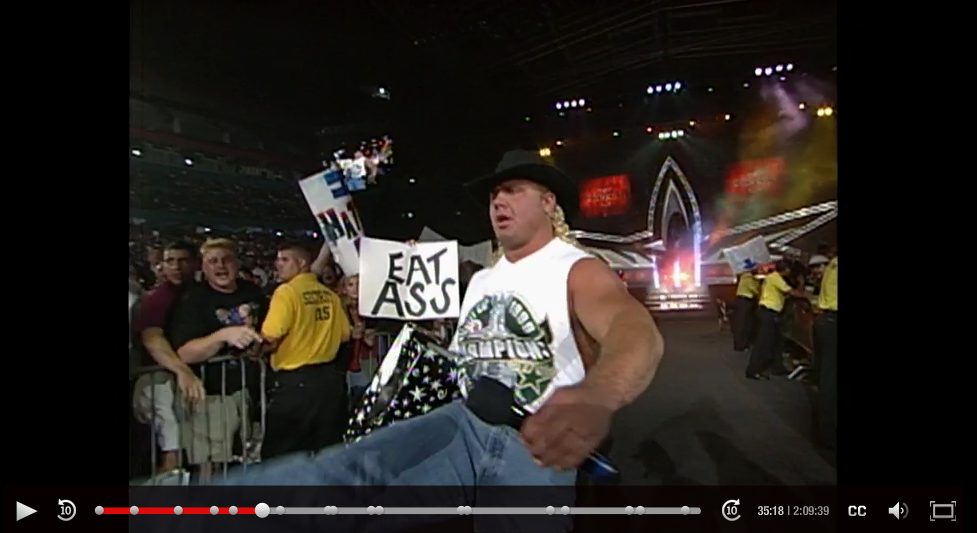Kayfabe by Maxwell Lord
The Other Other Wrestling RPG
Original SA post Kayfabe: The Other Other Wrestling RPGOne thing about wrestling fans is, by and large, we pay a lot of attention to the business side of things. Pretty much every fan these days is a “smart mark” or smark, someone who knows the outcomes are predetermined but likes to lose themselves in the drama. Even in decades past, when wrestlers worked hard outside the ring to maintain “Kayfabe”- the Masquerade-like illusion that this is all real- newspaper surveys indicate that an overwhelming majority of people knew what was up.
Because we know it’s scripted, we’re interested in what the people behind the scenes are doing, why they’re pushing one wrestler over another, and also, how they’re doing. In the absence of sports statistics, we talk about ratings, live attendance, and PPV buyrates. We want the promotions we follow to do well, for wrestling to be popular- but at the same time we want to be able to get caught up in it.
And of course, we like to think we can do better. Fantasy booking is a common thing, coming up with plotlines and matches we’d like to see, and actually trying to organize whole promotions- “e-Feds”, we call them- using real or made up talent. It’s at the root of a lot of backyard wrestling (well, that and your average teenager’s total lack of self preservation instincts), and there’s even a long running computer game series, Total Extreme Wrestling, that’s all about managing a wrestling promotion.
This is why I was interested in Kayfabe, the game, which bills itself as “The Inside Wrestling RPG.” It’s a perspective other tabletop wrestling games on the market really don’t take. WWE Know Your Role, and its spiritual successor Wild World Wrestling, have the wrestlers in a given match actually trying to win, as well as gain popularity- the victor is determined by the roll of the dice. World Wide Wrestling has match outcomes predetermined by the GM, and is more purely about trying to get your character over, but every move you make in it is supposed to be something that happens “on camera”. Kayfabe, which actually predates these games (it has a copyright of 2003), is more about the business.
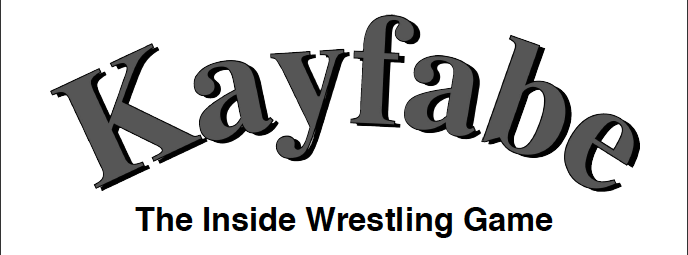
“Introduction” posted:
Kayfabe draws you into the wrestling industry
like no other game has before. Set up your own wrestling
shows, while at the same time dealing with all the personal
issues and drama that takes place behind the curtain. The
premise behind Kayfabe is that you and the other players
have set up your own independent wrestling promotion in
hopes of one day rising to the top of the wrestling industry.
Smart wrestling fans know that there is far more to the world
of professional wrestling than two guys getting in the ring
and beating each other up. There is a lot that goes on behind
the scenes and in the ring that isn't apparent to the
casual wrestling fan. Kayfabe, takes into account all of the
behind the scenes intrigue, negotiating and drama that no
one sees, as well as the actual wrestling we all watch on
television. Players take on the roles of the writing staff and
wrestlers throughout a series of televised shows and a climactic
Pay Per View event
The basics: Kayfabe is by Matthew Gwinn at Errant Knight Games- some additional material came from Cynthia Celeste Miller (of Cartoon Action Hour), Eddy Webb (of Pugmire), David Creighton, Janet Johnson, and Ron Edwards. It’s available from https://www.errantknightgames.biz as a PDF, with a caveat- when I first paid for the game via Paypal, for a day or so nothing happened. I shot an e-mail to the site, and Gwinn apologized, said Paypal isn't being consistent on notifying them of these things, and gave me a download link. It would be nice if this were on, say, Drive Thru, but whatever. So if you like it and want to buy it, do be prepared to give ‘em a nudge.
Is it good? Let’s see! (Honestly I’ve only looked some at this book. Seems okay so far.)
The game is designed for at least 3 players, one of whom will be the Booker. It works on a “troupe” model of play, similar to Ars Magica, with each player having multiple characters, those being wrestlers, managers, and other talent. They also will each be playing a member of the promotion’s booking committee- the Booker may make the final decisions, but you try to influence them.
The “Starting A Campaign” chapter talks about Shows and Series; a one-shot game of this might revolve around booking a single wrestling show, where a campaign might involve multiple shows. Running a Show is broken down to three parts. In the Booking Committee, the players are the writers, deciding what will happen in the show, from matches to promos to backstage segments and the like. The Booker uses this to create a Booking Sheet for the show.
The Locker Room Session is “where the majority of the roleplaying of Kayfabe takes place.” This represents the time between the posting of the booking sheet and the actual running of the show. Wrestlers and talent react to the plans, resolve other off-screen issues, and can try to influence the final booking of the show in their favor.
“The Death of WCW” posted:
The Steiners were scheduled to take the [tag team] belts, but in the end, it didn’t happen. [Scott] Hall and [Kevin] Nash went up to Bischoff backstage at the PPV and said the frequent title changes were hurting the drawing power of the belts. Therefore, they argued, they should retain against the Steiners. Bischoff assented. The irony of all this was that [Lex] Luger, who had just won the WCW title six days earlier at Nitro, didn’t get to retain, and dropped the belt instead to Hall and Nash’s good buddy Hogan [I don't have to say who this is]. The next night on Nitro, Luger was hardly mentioned at all. This upset more than a few of the boys in the back.
And finally there is The Show, where the Matches, Interviews, etc. all actually play out in front of an audience. The paragraph describing this in this chapter gets cut off, but the rules will come later; in summary it’s all about trying to gain Heat on every segment, and the total Heat will determined the ratings and overall reception.
The chapter closes talking a bit about the Series, the default structure of which is eight Shows building up to a Pay-Per-View. The way wrestling has worked ever since the introduction of TV is, promotions will use the TV show, which viewers basically get for free, to convince people to spend money on an upcoming supercard where titles may change hands, big stories get settled, etc. In the days of regional promotions the supercard would be a live event playing somewhere in the area, which you could only see by attending in person; in the 80s this gave way to closed-circuit broadcasts of the likes of Wrestlemania and Starrcade, and then the Pay-Per-View market took over as cable became widespread. Nowadays, the WWE mostly tries to get you to see these events on their streaming service, the WWE Network, while indies may focus on iPPVs or live shows. Basically what I’m saying is that despite the “PPV” term, this structure can be adapted to various eras of wrestling.
Next up will be Character Creation, and I’ll try to explain the system some.
Building a Roster, or "How to quantify bad life decisions"
Original SA post
Part Two: Building a Roster, or "How to quantify bad life decisions"
Character creation in Kayfabe is pretty quick, which is good because you’re going to be doing a lot of it. Setting up a wrestling promotion requires a Talent Pool, and the game recommends each player create from 4 to 10 characters. Most of these characters will be wrestlers, but there are also Valets, Managers, and it’s even possible to do Untrained Talent- people like commentators, backstage interviewers, etc.
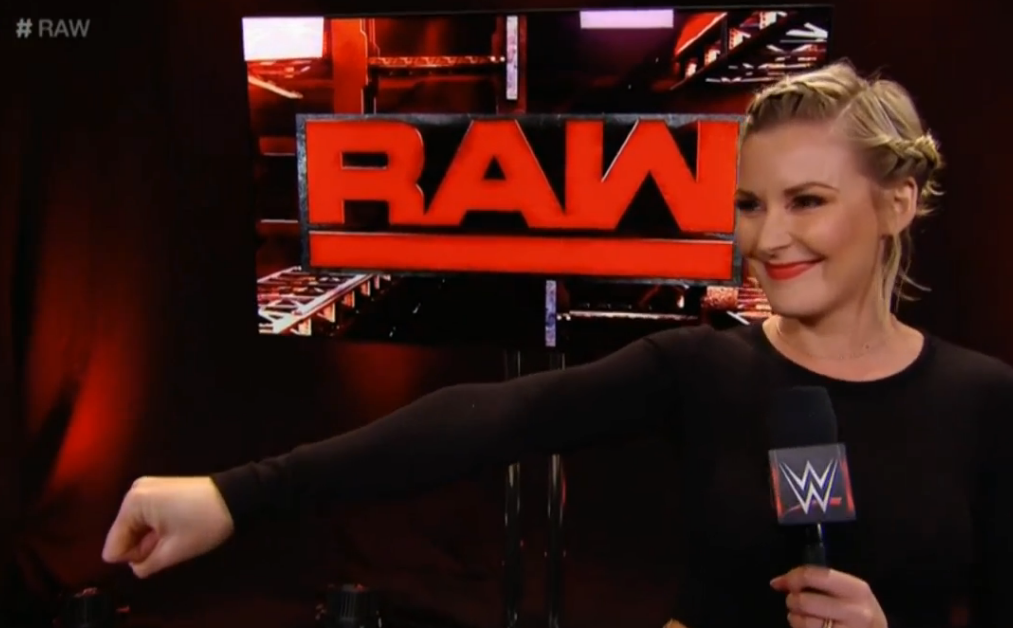
Pictured here, backstage interviewer Renee Young being awesome.
Wrestlers themselves are divided into four categories. At the lowest rank on the pole are Backyard Wrestlers. Yes, the game actually does support playing a backyard federation, which is interesting when you consider that Backyard Wrestling is itself a kind of full-contact LARPing. Of course if you’re not playing a yard fed there’s no real point to these guys. Wrestling Students are still learning the ropes, literally- these guys will mostly show up if the promotion is a Wrestling School (as many small promotions are), but an indie fed might use them to job out as well. Starting Wrestlers are what the game says most of your Talent Pool should consist of, but the game also recommends each player create at least one Experienced Wrestler.
If you remember the intro paragraph, the game basically defaults to an assumption that you’re running an indy fed, big enough to have actual shows and PPVs but not quite where the big boys play. Here, the game establishes that further by saying any Experienced Wrestlers you create should have some reason they’re slumming it- they’re past their prime, they just don’t have Heat, etc.
Valets and Managers being distinct threw me a bit. They serve a very similar role, they’re someone who stands in the wrestler’s corner during a match and often interferes on their behalf or causes some other ruckus. The main difference is the real job of the Manager is to speak for their wrestler- they’re often paired up with people who aren’t used to the mic yet, or can’t speak English, or whatever, to help them get over. A good example in current wrestling is Paul Heyman, who “manages” Brock Lesnar in WWE- Heyman spits fire on the mic, and Lesnar just has to stand there and look intimidating. Managers often have some wrestling experience themselves, not the least because their job often leads to them being choke slammed, thrown over the ropes, etc.
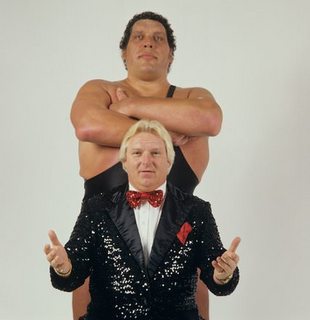
RIP
Valets don’t do a lot of talking, they’re mostly there just for support- the common sight is a beautiful woman acting as arm candy for a male wrestler, which inevitably leads to romantic subplots, betrayals, and similar drama. But male valets are also often there as flunkies, personal ring announcers, human shields, etc. (Another current WWE example, the wrestler Carmella has her boyfriend James Ellsworth, a goofy-looking schlub of a guy who she has taken to leading around on a leash and guys I’m thinking Vince McMahon may have some issues.)
Sticking with wrestlers for now, you’re first asked to do some thinking about their background, general backstory stuff like their goals, friends, enemies, etc. You should name three people important to them, and describe the main thing they consider important as well- whether it’s proving yourself, becoming a star, having a good time, etc. You then pick a couple of Trademark moves and your Finisher- these don’t really make a difference mechanically.
Next we get into Traits, of which there are four: Wrestling, Work Rate, Mic Skills, and Clout. The way most rolls work in this game is, you roll a number of d6s equal to your Trait, and if any of them are 6, you succeed. There are also opposed rolls- these are decided by who rolled the most 6s, and if that’s not enough then by who has the highest total, and after that the Booker decides. The game does say that most rolls will be for Wrestling, so there may be an issue of one stat being the best to have, but we’ll see.
Wrestling is mostly about the technical aspects, how good you can execute moves and sell your opponent’s, etc. Work Rate might be better termed “psychology”- how well you read a crowd and tell a story in the ring. It also represents how much other wrestlers trust you in the ring. Mic Skills are your acting ability, and Clout is your influence behind the scenes, how well you throw your weight around.
A Starting Wrestler gets 12 points to buy Traits. Untrained and Students get 6, Backyardigans get 4, Valets 8, and Managers and Experienced Wrestlers both get 18 and are the only people who can buy Traits higher than 5 with these starting points.
And now, Assets & Flaws! Because of course there are!
These are bought on a one-for-one basis- for every Asset you want, you have to take a Flaw. This is the game’s biggest mechanical weakness, since they’re not balanced 1-for-1, and some are clearly more impactful than others. There are also some that really only serve to raise or lower Traits- that does let you vary things beyond what the initial point totals and limits allow, but that’s it. Some traits let you take them more than once, with a cumulative effect.
The game also says that the Booker may award or take away Assets or Flaws as a result of roleplaying, to reflect things changing, which is… I dunno, may be best to let the player decide.
Listing all of these would take a long ass time, and a lot of them involve mechanics that haven’t been described yet. Flaws come first since this is a sleazy carny business, and can represent things like addictions, constantly risking injury in the ring, having burned bridges in the industry, having a contagious disease, etc. There are also some that are just bland, like Bad On The Stick, which just lowers Mic Skills by 1. Some don’t have obvious mechanical effects- Limited Availability just means there’s a specific reason the wrestler won’t always be free (travel restrictions, has another job, etc.), and Poor Judgement just means you’re prone to making bad decisions (note: this is almost everyone in the wrestling business.)
There are some I find particularly interesting, though. A Dirt Sheet Target has one or more major wrestling fan publications out to get him (maybe for legitimate reasons)- they continually trash him in the press and watch out for you making waves in the locker room. This means anytime you want to spend Clout you lose Heat. A character with Fan Disdain just gains less Heat from every match- whatever you do the crowd just doesn’t like you. Fan Expectations means they expect too much, because you’re a legacy or come from some other sport or whatever, so whenever you fail a Wrestling roll you lose more Heat than you would. (There’s also a promotion-side version of this, Unrealistic Expectations, where you lose Clout when you screw up.) There’s even Negative Phantom Heat, which represents the promotion thinking that you’re less popular and deserving than you are, and that affects how much you get paid and your backstage Clout.
Assets are not quite as sexy, and also fairly wide ranging- from things like Acting Experience, being an Aerial Tactician (which gives you a bonus when performing moves off the top rope), being Financially Secure, or being Canadian. Yep- Canada has a reputation for great wrestlers, so being or even pretending to be Canadian lets you start off with an additional 5 Heat. I kinda like this. You can even start off with a spouse higher up in the company. On the downside there are still some bland ones, like “Match Psychology” which just gives you a point of Work Rate. Again I can see a role for this mechanically- if it’s important to you, you can start with a Trait higher than 5- but eh.
So basically, yeah, this is a very 2003-ish thing for a game to have, and like a lot of asset/flaw systems from around this time it's not precisely balanced and some of them are just writing down "is X". Oddly enough, when we get to promotion creation, things get a little more rigorous, so maybe Gwinn didn't feel he had time to rebalance the character creation part. That said, it's quite workable and prompts you to think about the person behind the character they're playing.
This is going long enough, so next post I’ll break things up with some examples! Suggest wrestlers, managers, on-screen personalities, etc.! I mean, there’s one I’m absolutely going to stat up, but any suggestions on your part will be glowingly appreciated.
Next Up: Examples and Finishing off Chargen
Alison BRIE MOOOOOOODDDDEEEEE
Original SA post
Part Three: Alison BRIE MOOOOOOODDDDEEEEE
Okay, no suggestions from the audience, but I came up with a few ideas anyway.
First, we’ll make a wrestler.
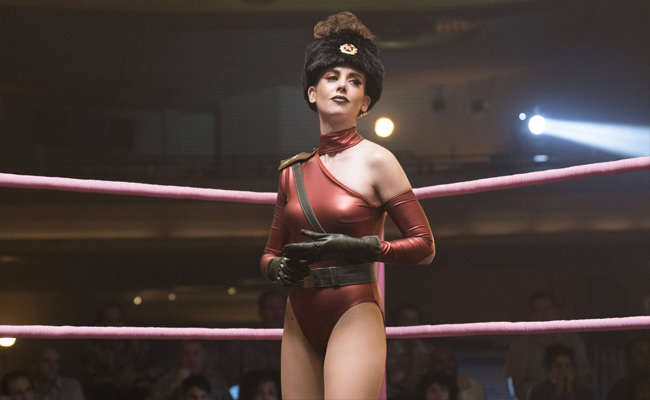
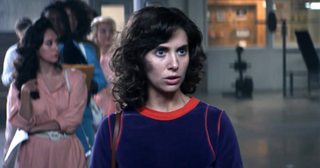
Ruth Wilson was a struggling actress in LA, going to auditions, finding no good parts, and living off Cinnamon Toast Crunch. She answered an open call for something called GLOW- and found out it stood for Gorgeous Ladies of Wrestling. And the rest- is on Netflix, it’s actually a pretty good show.
Her wrestling gimmick is Zoya the Destroyer, a Soviet superwoman with a grotesque Boris Badenov accent. She is here to crush your decadent Western capitalism, and fill your swimming pools with borscht! For Trademark Moves we’ll put down such combos as the Hammer and Sickle and the Rough Toilet Paper, and her finishing move is a devastating piledriver she calls Vodka For Breakfast.
Anyway, so, as a Starting Wrestler Ruth gets 12 points for her stats. For Wrestling, we’ll give her 2. She’s just barely been trained, but based on some of her moves I’ll say she’s basically competent. Still has some way to go. Mic Skills get maxed out to 5- she’s a damn good talker. Work Rate is 3- she’s a little better at reading psychology and keeping the crowd engaged, she sorta gets the wrestling thing, but again, still green. That leaves 2 for Clout- she’s basically happy to have a job, is smart enough to be aware of things, but is not yet throwing any weight around. Like all Starting Wrestlers Ruth begins with 5 Heat.
Flaws and Assets come next. For Flaw, we choose Tainted Past- Ruth has slept with her best friend’s husband (well, former best friend, and former husband, basically), and not only has that tainted that relationship, it’s kind of a cloud on her in general. Also the guy still shows up sometimes so that’s a problem. To balance that out, she gets a level of Acting/Performing Experience: she’s no star, but she’s an actress by training. That bumps up her Mic Skills to 6, so yeah, she’s going to be cutting a lot of promos.
So to summarize:
Name: Zoya the Destroyer
Real Name: Ruth Wilson
Character Type: Starting Wrestler
Wrestling: 2
Mic Skills: 6
Work Rate: 3
Clout: 2
Trademark Moves: Hammer and Sickle
Rough Toilet Paper
Finisher: Vodka for Breakfast!
Gimmick: Russian Superwoman
Assets: Acting/Performing Experience
Flaws: Tainted Past
Heat: 5
Injury: (Nothing yet)
Let’s try something else, next. A Manager! I was kinda stuck on this, but I recently saw this movie again so:
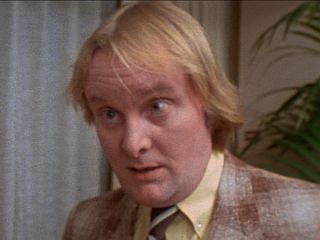
Ian Faith is a veteran. He knows it’s a bastard of a business out there- okay, technically he’s used to managing rock stars, but wrestlers are basically the same, right? Overgrown teenagers who like to drink, do drugs, and contract STDs. I see this guy as working for comedy midcarders, doing the dirty work while their backs are turned, that sort of thing. No signature moves or anything, but he does like to carry a cricket bat.
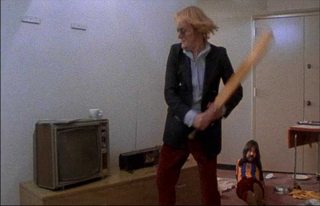
So we’ve got 18 points to work with, which is yeah, quite a lot. For Wrestling I’m thinking as low as 1- he’s basically a Jim Cornette type, will take some spills but not actually perform moves. Mic Skills are 6 (remember, managers ignore the upper limit.) Work Rate, I’ll give a solid 4- he may not know any moves but he’ll be good for hustling around the ring and distracting refs and so on. This leaves a whopping 7 points for Clout- he can bullshit his way around backstage like nobody’s business. Starting Heat is 10.
One major Flaw I can think of for this guy is simple- he’s not really much of a guy to promote himself. He’s nothing without someone to back. So, I’ll give him Lackey. This means that after the promotion is created and the roster’s been decided, he picks a wrestler who is basically in charge of him. At any time, that wrestler can force him to either initiate or cancel a Clout roll.
What would be a good Asset to balance this? This has nothing to do with anything in Spinal Tap, but I’m actually thinking Financial Security. Ian doesn’t have to worry about his own money- the typical financial struggles of being an independent wrestler simply aren’t his concern. The description specifically says this doesn’t make a character rich, it’s just that money troubles won’t come up.
So here the system isn’t quite able to describe all the nuances of the character- there’s nothing to mark someone as temperamental, for example (guy also seems to have some issues with women and there’s the one time he drops a line about “the local Hebrews”- but maybe that's best kept away from the table). You don’t necessarily need specific Flaws for every character quirk but if you’re already dealing with some intangibles for a character, it seems the list could be more comprehensive.
Name: Ian Faith
Character Type: Manager
Wrestling: 1
Mic Skills: 6
Work Rate: 4
Clout: 7
Gimmick: Hard hustling agent/manager shielding his wrestlers from the effects of their own stupidity.
Assets: Financial Security
Flaws: Lackey (as yet undetermined)
Starting Heat: 10
Injury: 0
And you know what, let’s do an Untrained Talent. Let’s do a commentator! Commentary is an important part of wrestling- good commentators can turn even the most routine match into The Most Important Event In The History of Our Sport, while bad commentators can ruin everything.
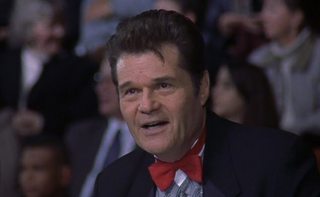
Buck Laughlin should not be here. He knows nothing about wrestling, but he is a beloved sports personality, he benches 315, and the promotion got him for cheap because the network also runs a dog show. He’s a color commentator, he’s supposed to tell the story of the match while the play-by-play guy calls moves.
So as Untrained Talent Buck has 6 points, but the good news is we need to invest exactly 0 points in either Wrestling or Work Rate. He’s not going up there, ever. This means we just have to split between Mic Skills and Clout. He’s not COMPLETELY hopeless when it comes to talking, so I feel like giving him a 2 allows for him to occasionally amuse someone with a good line. Clout, then, gets 4. Starting Heat is 1.
Now in theory “Half Hearted” should be this guy’s perfect flaw- he’s a complete outsider here for a payday. The problem is that mechanically this reduces his Work Rate by 1 and he’s already at 0, and so- I mean I’m assuming you CAN just take it and have it stay at 0. But the other consequence is “his matches all loses (sic) 5 Heat” and since Buck is an announcer this could basically mean EVERY MATCH, and the promotion isn’t that suicidal. This points to another problem, most of the Assets and Flaws have wrestlers in mind- some just don’t work for Managers and Valets and the like. Sure wrestlers will be most of our characters but it does mean slim pickings for other guys.
But there are two Flaws that look quite attractive. One Trick Pony is great for Buck. He cannot be anyone other than who he is. His Clout is 1 higher in regards to changing and altering his gimmick, 1 less in all other cases- so most of the time he’s only got an effective Clout of 3. The man’s not gonna change! Don’t ask! And the other is Poor Judgement. This is sort of a catch all, as I said earlier. Buck is gonna hang out with bad people, make bad career choices, and almost certainly incur the occasional problem with S&P. This does kinda rely on a good GM to make sure this has consequences, but such is rules light.
Assets to balance! It’s kind of amusing that I’m having a harder time with Assets than Flaws but then again I’m choosing characters from heavily improvised ensemble comedies. Established Fan Base is the best way to describe Buck’s prior sports familiarity (I forget what it is he’s actually done)- people know who he is and like him for it. He gets 5 extra Heat and 10 “Nostalgia Heat”. Nostalgia Heat is defined much later in the game- it’s a sort of Phantom Heat in that it counts for contract negotiations and backstage maneuvering, but can count against Match Heat (this gets complicated and I’ll explain it when we get there.) Thing is, Buck is never going in the ring ever so who cares. He now has an effective Heat of 16. He’s hotter than anyone in this company! Oh yeah they LOVE this guy backstage.
And honestly this guy would get nowhere if he weren’t so likable, so Natural Charisma is the most advantageous thing here. This gets you an additional die in either Mic Work or Clout, and we’ll go with the former- representing the fact that even though this guy has no fucking clue what he’s talking about, the audience just kinda forgives him, you know?
But yeah, we’ve got a lovable, completely out of place buffoon who is frankly bordering on untouchable. We’re stuck with this guy. Fred Willard is OP.
Name: Buck Laughlin
Character Type: Untrained Talent
Wrestling: 0
Mic Work: 3
Work Rate: 0
Clout 4
Assets: Established Fan Base, Natural Charisma.
Flaws: One Trick Pony, Poor Judgement
Heat: 6, + 10 Nostalgia Heat
Injury: None
And wow that’s a long update, so NEXT TIME I will actually finish the Character Creation chapter. It’s not really very long.
Next, no, seriously, the last of Character Creation
The Rest of Character Creation, or, Wrestling Thermodynamics
Original SA post
Part Three: The Rest of Character Creation, or, Wrestling Thermodynamics
Now there’s one special category of Assets and Flaws to talk about : Good and Bad Reputations. These are only open to Experienced Wrestlers at Character Creation (though one could assume Managers and maybe some Personalities could have them as well)- otherwise you get them through play, as a reflection of decisions that character makes.
Good Reputations are things like being a good Company Man, being Easy to Work With, the company’s Golden Child, or just Trustworthy- there’s even a catch all one that’s just “Good Reputation” and means you’ve stayed out of trouble. Locker Room Leader is one worth describing too, since that can be an important thing in wrestling- wrestlers can be a very ornery bunch sometimes and there needs to be an adult in the room to get everyone organized and ready to go. (This is reportedly why Roman Reigns has such strong backing.) Bad Reputations may be that your character is unsafe, refuses to job, is injury prone, etc. Some of these Reps don’t actually have mechanical effects, other raise or lower Clout, Work Rate, affect crowd Heat, etc.
Okay, Heat. It can go up or down based on your characters’ on air performance. Interviews, Promos, and Skits all will call upon your character making a Mic Skills role. If the role succeeds, you increase your Heat by 1 for every 6 that you rolled. If you fail, however, your Heat goes down 1 for every 1 you roll. Meaning you can fail a promo and lose no Heat, which is good.
Matches are a bit more complicated. Each Match will end with a certain amount of Heat, and you compare that to the existing Heat of the wrestlers involved. If it’s higher than your existing Heat, you gain some Heat- if it’s lower, you lose some. This is where Nostalgia Heat can hurt you- it means people expect more of you, and they’re disappointed if you don’t live up to their memories. By contrast, Phantom Heat isn’t counted here because it reflects what the promotion thinks of you.
How much Heat you get is also influenced by what kind of match it is. If it’s just a normal match on a regular show, you gain/lose 10% of the difference; if it’s a main event of a TV show, it’s 30%; if it’s a PPV match, 50%; finally if it’s the main event of a PPV, you gain or lose the entire difference. All fractions are rounded up.
It’s hard to judge all this without figuring how much Heat an average match is gonna generate, so we’ll come back to this later.
There are, of course, Squash matches. While in theory the virtue of pro wrestling is you can book every fight to be an exciting back and forth, it’s a long tradition to throw in a few matches where one wrestler just dominates the other- the idea is the winner is someone you’re trying to make look like a big threat, and the loser is not someone the audience is likely to even remember. In a squash match, the winner gains an additional point of Heat over any awarded, while the loser cannot gain Heat- however, both the winner and loser can lose Heat if the Match Heat is lower than theirs.
A Wrestler can also choose to “Put Someone Over”, that is, give up 50% of their Heat which is instantly transferred to another Wrestler. This is usually played out as losing to them in a match (or having a big even fight if they’re much lower on the pole than you), but it can also be done via a promo. It’s rare, but it happens, especially when a wrestler is close to retirement.
Finally Commentary can help give Heat to a wrestler if it’s specifically targeted (this is explained later), and at any point the Booker can look at the behavior of a given wrestler and say it warrants a change- maybe they do something positive and public like backing a charity, maybe they do something really stupid and no-show an event or get arrested.
Traits, meanwhile, are improved not by spending Heat or any other resource, but by making use of one of the Promotion’s own Traits, Facilities/Staff. To train, you roll the Facilities/Staff Trait minus the rating of the Trait you’re trying to improve- a successful roll means the Trait increases by 1. This does presumably mean that if you’re at or above the Facilities/Staff rating you really can’t get much better, but ideally the promotion is growing too. It is kinda weird that Clout is a part of this- why would a promotion actively help you to get better at manipulating it?- but I can think of some ways to explain that away.
And finally- well, strictly speaking, before listing the Reputations- the book explains that after each Show, the Booker can decide to add or remove Assets, Flaws, or Reputations based on what’s happened. You’ll notice already, this is a system that gives a LOT of power to the GM- it’s not necessarily a bad thing if everyone’s on the same page, but that’s always the concern.
Next Time: We begin the process of looking at how this game is actually played, with The Booking Committee.
The Booking Committee or, Vince Russo Simulator 2003
Original SA post
Part Four: The Booking Committee or, Vince Russo Simulator 2003
Actually playing Kayfabe is divided into three parts, as described in the intro, and the book handles each in turn. So first up we have the Booking Committee, the least mechanical part of the game. Here everyone takes the roles of writers creating the Show. Each player should come up with at least one Interview, one Promo, one Skit, and one Match- they can do more, obviously, and you don’t necessarily have to work alone. It’s expected that there will be a lot of back and forth, but the game says to set a time limit on how long this phase takes- anywhere from hours to days (PbP presumably already being a thing by 2003.) At the end of that time the Booker takes all that the writers have come up with and finalizes it into the Booking Sheet.
The game assumes a 2 hour standard show (though realistically 30 minutes of that would be commercials)- they don’t really force this and obviously PPVs will be longer, but “How long will this segment be” is one question you’re asked to consider. The game says that most matches on a regular show will be 10 minutes and under (though I think as of late the WWE is much more commonly having matches go over that and throwing in a commercial break), whereas any of the other segments might be anything from 30 seconds to 30 minutes long. The other questions are a bit simpler- Who Will Be Involved, Why Is It Important, and What Effect Will The Scene Have.
We get to talking about creating a writer next. Unlike the other characters we’ve made, writers don’t have stats- they’re just the personality you use when deciding what you’re going to write. You think about their background and what kind of style they want- are they an old fashioned, straightforward wrestling booker who treats the whole thing very sport-like, are they into booking Big Moments and shocking twists, do they try to come up with elaborate arcs, etc. The one mechanical thing is you can choose a focus- whether it’s Matches, Interviews, Promos, or Skits- and you can substitute an extra one of those in lieu of another required type of scene. (So someone who focuses on Skits might do an extra one of those but not submit a Promo, etc.)
Okay there’s a bit of confusing writing here- “Once the Booking Sheet has been posted writers must make Clout rolls like anyone else if they want to change something. Only characters with a Clout Trait can change the Booking Sheet.” The NEXT paragraph talks about how writers can sometimes become On-Air characters, at which point you have to stat them up, so THEN they can use Clout to influence things. Okay, I think I get it.
Even though the player will have a bunch of characters they made, the game defaults to an assumption that you won’t necessarily favor “your guys”. However, wrestlers with the Asset of Married to the Business, Born Into the Business, or Friends In High Places may form an alliance with one of the writers- as a writer you make a note of such wrestlers, to indicate you favor them.
Though the Booker’s role is kind of detached, it does say that the Booker can more actively take on the role of the Promoter during the Booking Committee- they can change anything they want to, obviously, since that’s a power the Booker already has.
The game suggests that if you fully role-play out the Booking Committee, in character and everything, the players should also be able to each bring a wrestler to sit-in. Wrestlers do sometimes sit on booking committees to get an idea of where things are going and offer input. A wrestler can use a Clout roll to change a suggestion by a writer (and since writers don’t usually have Clout of their own it will often be unopposed), but the Booker still has the final word. Finally the book says wrestlers can be a part of a Booking Committee, but that historically this is a very bad idea. A wrestler needs a Clout of at least 8 to even try.
Then we break down the four types of scenes described earlier. Matches come first, and the obvious is gotten out of the way- who’s in it, how long is it going to take, and who will win. The writers don’t actually have to define who will win since that is down to the Booker, but you can suggest who you feel should, and I can see this being a big opportunity for negotiation and roleplay especially if the Booker plays the promoter. In talking about the time limit they again say that TV matches will usually run from 2 to 10 minutes. Now, this was 2003- I wasn’t watching wrestling at the time, but for pretty much all of the Attitude Era the then-WWF’s shows did tend to have short matches broken up by lots of skits and craziness. Nowadays the matches go a bit longer but their roster is deeper and Raw is 3 goddamn hours long so something has to take up time.
There’s also the question of what titles, if any, are on the line. This is one of the few rulesy bits of the chapter, because to simulate the importance that titles can have to a promotion, each title has a Heat requirement for the wrestler to hold it. Wrestlers with a lower Heat than the Heat requirement can take the belt, but this causes the promotion to lose 1 Heat for each show the wrestler has it.
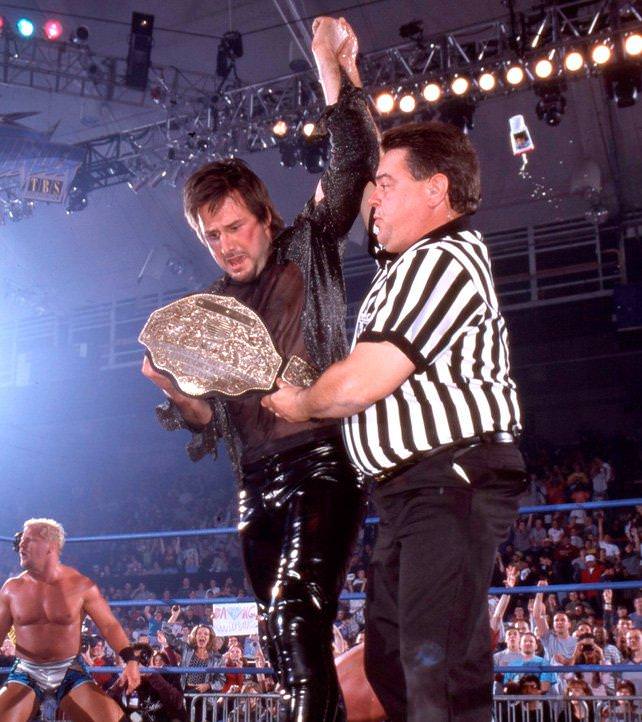
There’s a list of Heat requirements for most titles- it’s generally derived by looking at the promotion’s overall Heat. World and Tag titles require Heat equal to the promotion’s Heat x2, most other titles require you have Heat equal to that of the promotion, and “TV” and “Hardcore” titles have no such requirement. (I’m not sure about the Tag Team restriction being as high as the World one, though.)
Promos are defined here (sort of, it’s kind of imprecise) as being verbal confrontations between wrestlers, in service of an upcoming match or ongoing story. They usually have one wrestler in the ring, they talk a bit and call someone out, then the person they’re calling out comes out to fire back at them. There can even be a brawl at the end, though the game recommends that this be kept short. (1 or 2 Move Sets, though this hasn’t been defined yet. The layout has problems.)
Interviews, somewhat counterintuitively, are just one wrestler talking- there can be an interviewer, they can even be staged as a “talk show” segment hosted by another wrestler (a la Piper’s Pit, The Highlight Reel, The Shelton Benjamin Show, you get the idea) but the speaker is the focus. You can also have “shoot” interviews where the wrestler breaks kayfabe- this is discouraged, but can be used to explain things like injuries or sometimes help turn a heel into a face by showing that they’re not bad, they’re just booked that way.
Skits are basically anything that’s not one of the above- two or more wrestlers doing… whatever. Conscious Skits are ones where the guys are deliberately playing to the crowd, Unconscious Skits are where we’re supposed to think this is live backstage footage and the wrestlers don’t know they’re being taped.
There’s a note about Booking for TV- if the promotion is one with a TV show, that show usually will be heavier on skits and promos and such than on the wrestling, because you’re trying to hook the casual audience with storylines, while if you’re doing local live shows you might want more wrestling, and PPVs will be almost all matches with a few bits in between. “Tricks of the Trade” is a sidebar basically defining some wrestling concepts like “Schmoz”, “Turning a Wrestler", “Screw-Job”, etc.
That wraps up this part of the Booking Committee. Next Time we finish this section with Tag Teams, Stables, Feuds, and Building to a PPV.
Tag Teams, Stables, and Feuds, or Wrestling Makes Strange Bedfellows
Original SA post
Part Five: Tag Teams, Stables, and Feuds, or Wrestling Makes Strange Bedfellows
The Tag Team section begins, “A strong tag team division is a vital part of any wrestling promotion.” Actual promotions often ignore this, but there’s a point to be made. Tag teams in wrestling are not just a variant type of match, but a way to partner wrestlers with contrasting strengths or styles, so that one can hide the weaknesses of the other and vice versa. A common approach is taking a guy who’s really good at talking and putting them with someone who’s strong and intimidating in the ring- another thing is to have one person take most of the opposing team’s offense, and have the other be the person who jumps in to clean house. It’s also a wrestling term that’s pervaded culture well beyond most; people who haven’t watched a minute of Monday Night Raw probably still will understand if you say “we should tag together on this”.
The basic rule for wrestlers becoming a tag team together is that they have to wrestle as said team for 3 shows before starting to enjoy the mechanical benefits of being a tag team. There are plenty of one-off team-ups that never lead to anything, and it takes time for wrestlers to get familiar working with each other in that style.
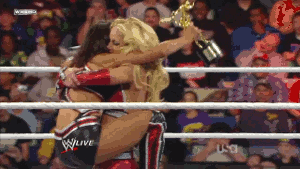
It is recommended, but not required, that your tag team members be BFFs
One of the bonuses is, for each full series (8 Shows and a PPV) the team has been together, they may roll an additional die (max 5) for Wrestling rolls during a tag match. It’s not a huge bonus but it helps. If a team splits up for more than a year they lose this bonus, and if they get back together they have to start up again. That’s a long time in wrestling so it’s fair.
A Tag Team’s Heat is equal to the average Heat of its members, rounding up. It changes whenever the Heat of its members does. When determining match placement on a show, you use the Tag Team Heat rather than that of the individual members. (Match placement has the match with the highest Heat go last, lowest go first.) Whenever both wrestlers are in a match together- whether they’re a Team, or one is just in the other’s corner- the Match Heat gains a bonus equal to 1/10 of the Tag Team Heat (round up again). Tag Teams can also have Phantom Heat, and if individual members have Phantom Heat, the average of that applies as Phantom Heat to the Tag Team Heat. (Being Phantom Heat it doesn’t affect the Match Heat Bonus.) There’s a paragraph about breaking teams up but basically says it can happen at any time.
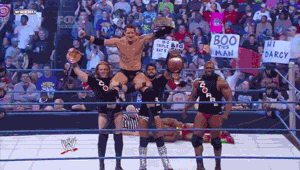
Stables are like Tag Teams in that they exist to help get over guys who might have trouble getting over on their own, by having other members cover their weaknesses. As such they’re often used when bringing up talent- The Shield, for example, marked the WWE main roster debut of Roman Reigns, Dean Ambrose, and Seth Rollins. Reigns was the guy who cleared house in the ring, Ambrose was the main promo guy because he had a good crazy persona, and Seth Rollins took bumps. The New Day are also an interesting example- Big E, Kofi Kingston, and Xavier Woods were all languishing at various mid-to-low levels in the WWE, E being a big guy who did power moves, Kofi being a flippy guy who almost never talked, and Xavier Woods being a small funny guy who never did much in the ring. Together they’re major merch sellers.
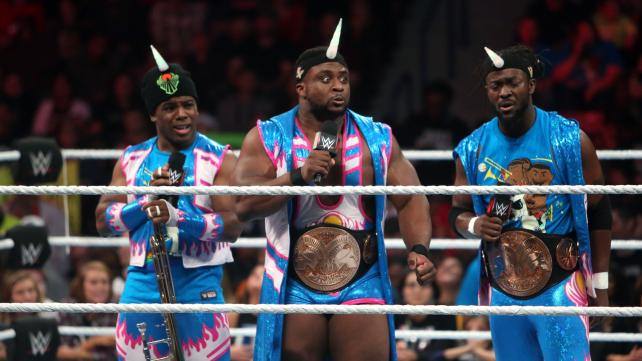
I have also been informed that they rock.
Stables can be any group of 3 or more dudes, and unlike Tag Teams can form in a single moment (they often make a show of declaring they’re now a group). There needs to be a Leader, usually the guy with the highest Mic Skills. Stable Heat is again an average of every member’s Heat, and in all other respects works like Tag Team Heat in terms of Match Heat and so on. Any non-Leader in a stable whose Heat exceeds the Stable Heet by more than half should be written out, but it’s not strictly a requirement. So you can have a main eventer leading a stable of freshly called up talent, and help to get them over, but you shouldn’t have two main-event level people in that stable.
Feuds are also a key thing in wrestling storylines- you can boil the vast majority of wrestling angles down to being a feud of some kind, whether it’s between stables or individual wrestlers. You choose the participants and work out why they’re going to be opposed to each other- one’s gonna be the face side and the other the heel, but there should be more to it than that. Characters can only be involved in one Feud at a time no matter what Vince Russo says. While a Feud is going, any match between the feuding parties gets a Match Heat bonus equal to 1/10th of their average Heat. Feuds also have Longevity, which is equal to the combined Heat of the opponents- for Stables and Tag Teams you use their Heat instead of the individual members. Every time the participants in a Feud have a Match against each other, you reduce the Longevity by the Time Limit of the Match. Conversely, every time a feuding wrestler/stable/team gains Heat from a Feud-related non-match segment (Promos, Interviews, Skits), the Longevity is extended by the amount of Heat gained. Generally this is why you don’t want the participants in a Feud facing each other very often until you’re ready for the payoff (usually a PPV match.)
There are four ways a Feud can end. One is the Longevity reaching 0- when this happens the previously-feuding participants shouldn’t face each other for at least another 8 shows. If you try to extend it, the participants each lose a point of Heat for each match they have together after the Longevity runs out. Face/Heel turns also end a Feud, because if both parties are Heels or Faces the dynamics have changed too much. The Feud also ends if injury or other reasons cause one or more participants to miss more than 6 shows in a row. It does say Tag Team and Stable feuds “rarely” end this way, so presumably as long as some of the members of the team are good the Feud can go on. Finally, if necessary, the Booking Committee can just end a Feud at any time. If they don’t give any explanation, though, the promotion’s Heat goes down by 1.
Feuds can be Rekindled, if ended prematurely- the Rekindled Feud will have Longevity equal to the Longevity that remained when it ended, plus the combined Heat of the wrestlers/stables/teams. In fact you absolutely SHOULD do this if Injury/absence was the reason things ended- once both participants are on the roster again, the audience expects to have some resolution, and if there isn’t, the promotion loses 1 Heat.
We now get into “Building Up to a PPV”. All the Shows you’re gonna run are basically going to be building to your PPV- as I said before, wrestling TV has always basically been advertising for paid events. This section focuses on doing it one match at a time, and breaks it down into four steps. Step one is The Tease, where you hint that there’s something brewing between the participants- something nice and vague, not obviously leading to a match. The book recommends doing this somewhere in the first three shows of the eight show cycle.
Step two is The Spark. This is the flashpoint which says “Okay, these two are definitely going to fight now”- whether it’s a declaration or a sudden brawl. This is also a good place to put a Swerve- that’s when the Tease hints at one thing and the Spark reveals something else. A good Swerve should ideally reveal a better match than the one you were teasing- say, you were setting the champ and his best friend up for a tag team bout against some heel team, but instead the best friend turns on the champ and now wants the belt! Swerves that don’t pay off can lower promotion Heat, but a good Swerve can add 1 to 5 points to the PPV match’s Match Heat.
Step Three is the Build, i.e. everything that happens between the Spark and the match itself. The wrestlers who will fight shouldn’t fight each other here- don’t give away the PPV match for free- but you can have all sorts of segments, and use each segment to try and build things. You can add stipulations, raise doubts about who’s the better wrestler, give them opportunities to antagonize each other, etc.
Step Four, the Climax, is, well, the climax. They note that this is usually done at the end of a Series (i.e. 8 shows and a PPV), but can be stretched longer, but the payoff should be a PPV match. (The build to Sting vs. Hollywood Hogan at Starrcade 1997 lasted most of the year.) Make the match something special. “Whether it’s a title change, blood and gore, nudity, super high flying action, an unexpected turn, or whatever, it should always leave the fans walking away thinking their money was well spent.”
Well, okay, Shawn Michaels was known for having people hook his tights so he’d moon the audience.
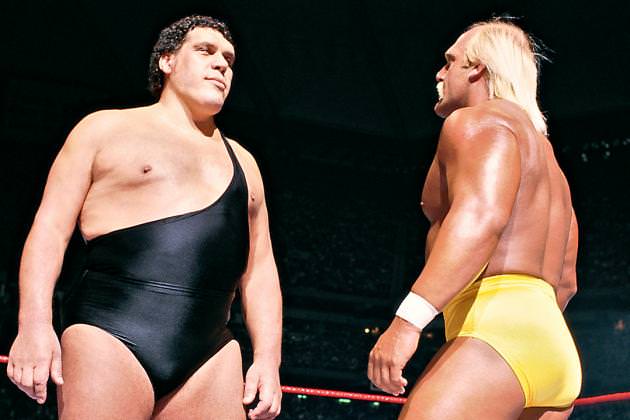
I’ll end with one of the simpler examples of this I can think of- the build to the main event of Wrestlemania III in 1987. It all started around January when Hulk Hogan was presented a big gold trophy to celebrate his lengthy run as WWF Heavyweight Champion. Andre the Giant, who was undefeated, was presented with a smaller trophy celebrating his streak. He seemed resentful and left without saying much. This was the Tease. The Spark came when he confronted Hogan, saying he wanted a title match- this was a big deal, because Andre had been a babyface, and Hogan’s close friend. And the Swerve was that he took on a manager, the sleazy Bobby “The Brain” Heenan, fully cementing his heel turn. It was easy to keep them apart for The Build, because back in the day the champ rarely wrestled outside of house shows and PPVs, but there were plenty of promos and segments which emphasized just how freaking huge Andre was, and how he’d never been bodyslammed let alone defeated. For once Hogan seemed at a disadvantage (even more so than when he had fought King Kong Bundy the year previously.) And of course, the Climax, where in front of the biggest live crowd the WWF ever drew, Hogan bodyslammed (sorta) the Giant and dropped the leg to retain the title. Granted it wasn’t the best match of the night (Ricky Steamboat and Randy Savage stole the show), but as spectacle it delivered, and Wrestlemania III was by some measures the most successful event in the WWF/WWE's history.
It’s just that easy!
But all that’s on paper. The talent still have to have their say, and they’re a rowdy bunch. So for the next installment, hold your nose and keep Randy Orton away from your gym bag, we’re heading into The Locker Room.
The Locker Room, or, Straight Outta Crockett
Original SA post
Part Who Actually Cares: The Locker Room, or, Straight Outta Crockett
The Locker Room starts with the Booker posting the Booking Sheet, based on all the input and suggestions of the players-as-writers. Everyone gets an opportunity to roleplay their characters’ reactions. Now it seems to me that with the “troupe” model and everyone having multiple characters, it might be a little confusing at this point- you may even have two of your PCs booked to fight each other. Part of this roleplay will involve backstage elements introduced by the Booker- conflicts between your personal and professional life, relationship developments, obligations, etc.
This is also where wrestlers can agitate to change things on the Booking Sheet, using Clout. The game says to roleplay the interaction first- the wrestler goes to the promoter and tries to persuade them to change things, and if it doesn’t seem like the promoter would be convinced, or someone’s arguing the opposite case, then you start making Clout rolls. It’s easier to alter promos and interviews- wrestlers with high Mic Skills in particular will usually be given a lot of leeway. However writers and promoters will often want a character doing an interview to hit on specific points, so as to create a coherent story.
After changes have been negotiated you can get into Plotting Out the Matches- the wrestlers in a match get together and work out how they want to play things out. Again they haven’t really just explained how a match works mechanically because that’s in the next section but from here it seems to involve narrating Move Sets between rolls, and players can agree that they’ll trade off narration every 1 or 2 sets or whatever. On the other hand it is possible just to wing it, and the game cautions against getting too detailed at this stage or else you’ll just repeat yourself in the match proper.
Next we get into using Clout. Once you get to the point where you need to make a Clout roll, it gets very simple- if the roll succeeds, the wrestler gets their way. The roll can be opposed by anyone who’s either in the same scene or would be affected by the wrestler’s request. The downside is, a character who fails a Clout roll loses a point of Clout. So it’s risky, which means there’s a reason to try and work things out before it gets to the point of needing a roll.
There’s another way you can lose Clout, and that’s by doing something really stupid. Showing up late or intoxicated, no-showing, getting arrested, intentionally injuring another wrestler, etc. Basically the Booker always has discretion to dock you Clout anytime you act in a way that would bring down the reputation of the character or the promotion. The Booker has a lot of discretion as to how much- the game suggests that you start with small punishments (say, 1 Clout the first time a wrestler shows up drunk) and add more if it becomes a clear pattern.
A character can never have less than 0 Clout- if you get to a situation where a wrestler would have less than 0, they should probably be fired. If the promotion has some reason to hang on to them (still under contract, etc.), they can instead bury them. Burial means a lot of things- getting saddled with a Bad Gimmick, losing a lot, being made to look weak/cowardly/etc. in matches, etc. A company can also bury you for other reasons- say, if contract negotiations are coming up, the promotion may try to reduce your heat so that you look less valuable to other companies.
On a completely unrelated note, WWE wrestler Natalya Neidhardt was once given an angle where she had uncontrollable flatulence. I’m not sure if contract negotiations were happening at this time, but it’s the sort of thing companies sometimes pull.
(The game also notes that a wrester who accepts this sort of thing gracefully may be let off the hook sooner. There’s no mechanic for this, sadly.)
The game says there are three ways of gaining Clout (so I guess the promotion’s Facilities don’t apply after all.) One is Paying Your Dues, which seems misnamed- if you made a successful Clout roll at any point during the Series, you gain a point of Clout after the Pay Per View. So there’s a reason to risk the Clout rolls as well as a reason not to try too hard too often- I like that. Another is Doing A Job- losing to someone with half as much Heat as you shows you’re willing to boost people lower than you on the totem pole and makes you more well-liked backstage, and again is worth 1 point. Finally at any point during a show the Booker may award a character a point of Clout if they feel it’s justified by something in-game, be it gaining a lot of Heat or doing something that would gain favor with the promotion or the locker room.
Next we get some detailed explanations for Phantom Heat and Nostalgia Heat. Phantom Heat represents when the people in charge are convinced someone is hotter than they are- that they’re the future, they’re the next Hulk Hogan or Ric Flair, etc. This is a common thing and the most recent example is probably, again, Roman Reigns- WWE tried to rocket him to the main event of Wrestlemania in 2015 but audiences just were not buying it.
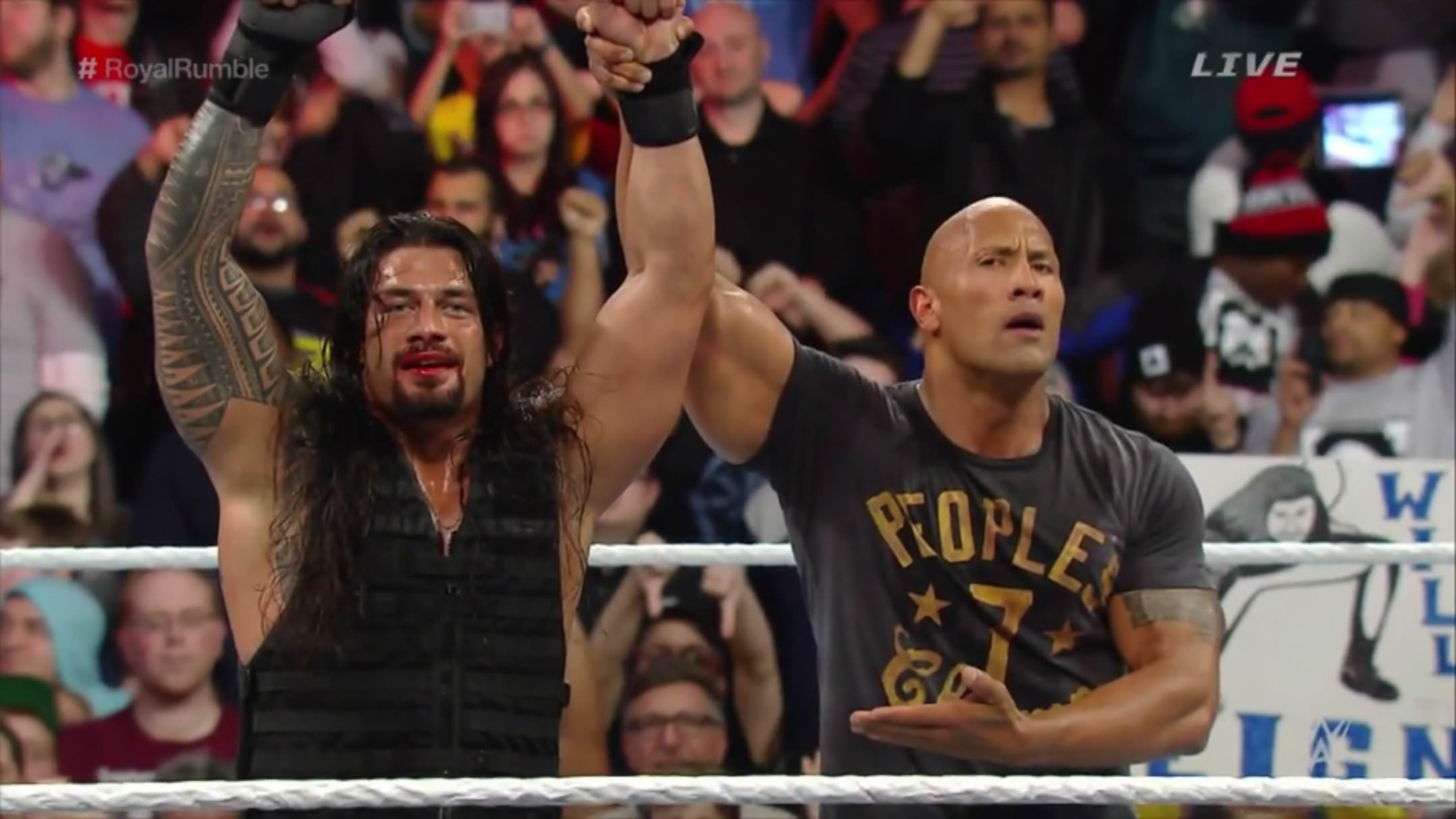
The crowd is booing the Rock. Think about that. Think about what you have to do to get people to boo the Rock.
Negative Phantom Heat is when the crowd likes someone more than the people on top do, so the promotion tends to keep him lower on the card. For a while WWE was convinced that beloved underdog Daniel Bryan was only “catchphrase over”- that is, sure crowds were doing the thing with saying “Yes! Yes! Yes!” and pointing in the air, but that was just because that was fun, they didn’t want to see him be a champ or anything. He did finally manage to overcome that apathy and main event Wrestlemania, but only when it became clear the audience was sour on the planned main event.
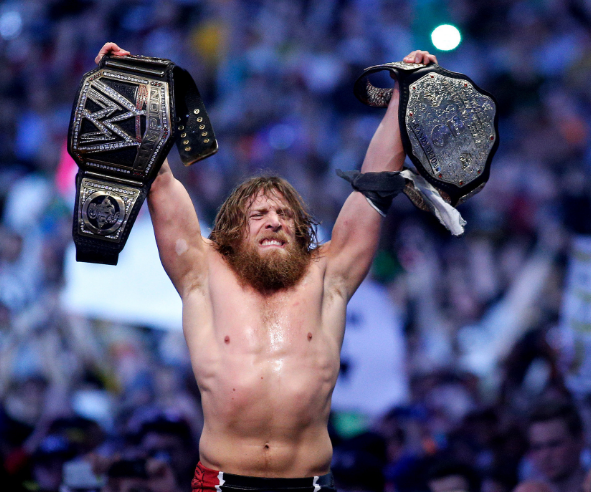
And then he got injured and eventually forced to retire. But it was a fun ride while it lasted.
Phantom Heat is counted as Heat when dealing with a wrestler’s pay, match placement, etc., but not things like Match Heat or other “fan determined” statistics. (This could be clearer.) It’s a positive or negative number, and you can’t have both at the same time- they cancel each other out.
Apart from chargen, you can get Phantom Heat- positive or negative- mostly from other wrestlers going up to promoters and talking about you. If they say good things, you get the good kind, if they spread lies and say you’re not over, you get the bad kind. In both cases the wrestler speaking for you makes a Clout roll- it’s unopposed unless another wrestler is present and speaks against them. If they succeed, you either gain positive or negative Phantom Heat equal to their Clout score. You CAN try and talk yourself up to management, but you roll one less die doing so. (I suppose you could also try to talk yourself down, but the book doesn’t say and why would you?) A wrestler can only have this done to/for them once per show.
Nostalgia Heat is simpler. It’s the love you get just for having been around for so long, based on people’s memories of you, rather than how you’re doing now. Wrestlers tend to stick around well past their physical peak, and we like to see familiar faces. Whenever you get some kind of permanent hit to your performance, you convert part of your current Heat to Nostalgia Heat. The general rule is 10% for each negative to die rolls or -1 to a Trait, but the Booker can adjust this higher or lower depending on how much the injury relates to what you were famous for- if, say, you have some permanent knee damage (a common thing for wrestlers), that could be worse if you’re a famous aerial luchador, but if you were always kinda slow and relied on your look and Mic Skills to do the job, it might be less of a hit.
Nostalgia Heat applies to everything outside of matches, and it applies to Match Heat until the match begins, at which point you work out what the Match Heat would be without it, and subtract that from the Match Heat. I am… a little unclear on this because the example does it wrong. Here I’ll paste it and see if you can work it out:
quote:
For example: If Magnus, who has 50 Heat, is wrestling Bahamut, who has 10 Heat and 250 Nostalgia Heat the Match Heat would start with a Match Heat of 155 (the average of 50 and 260). Once the match begins the match Heat would be reduced to 30, which means the match would haveto generate 20 Heat for Magnus to increase his Heat and 125 Heat in order for Bahamut to increase his Heat.
The way I read the rule, though, the Match Heat should be reduced BY 30, taking it to 125. It doesn’t have to gain any more Heat for Magnus to improve, but Bahamut would need the match to gain at least 135 Heat to not lose any. (Maybe getting Heat worked differently in an earlier draft.)
I THINK my way works- basically Nostalgia Heat means you have to work harder to actually deliver a good match. Agh. This is annoying because I otherwise get it, and in a game that’s been pretty rules-light so far each individual point of confusion is, well, amplified.
There follows a section on Backstage Politics that takes the form of an excerpt from a book by Magnus Von Magnus (presumably the example guy), called The Glass Ceiling: Lessons in How to Keep Your Spot. This is basically an entire section on how to be a total bastard. It’s an enlightened brand of self-interest, mind you- you can job to people you trust so long as you get your win back later, you should seek to gain the trust of the roster, but also make others look back, yeah. On the one hand you have to be VERY careful encouraging- hell, allowing- this kind of behavior in any game that isn’t Paranoia. On the other, this being a game where everyone has a bunch of dudes may soften the blow of any treachery- at least if the players are above board. Of course the section is purely fluff, close to in-game fiction really, and if nothing else it does illustrate an attitude that some wrestlers have, and some of the techniques they use.
Next we’ll finish the back half of The Locker Room with some more mechanical details- Contracts, Steroid Use, Drugs, and Injury!
Contracts, Injury, Drugs, and Rehab: or, Let's Be Careful Out There
Original SA post
Contracts, Injury, Drugs, and Rehab: or, Let's Be Careful Out There
Contracts! Unless the promotion is set up so that everyone is under contract, wrestlers can’t start with them unless they’re Experienced Wrestlers or Managers. Everyone else has to wait until after their first PPV. They’re desirable because they mean reliable money, but at the same time they’re an opportunity to bargain for various points.
Contracts come in three forms- Guaranteed, Incentive-Based, and Per Appearance. A Guaranteed contract gets the wrestler a base pay per show based on their stats at signing. Wrestlers, valets and managers use their Heat at signing times a dollar amount (for wrestlers it’s x $10, for the rest $5), other personalities use a stat times a dollar amount- for Refs it’s Work Rate, for all other on-air personalities it’s Mic Skills. Basically this is good for established Wrestlers, not so much for newbies.
Incentive-based Contracts divvy up your pay between a base rate and a per-show bonus. The base pay per Series is determined by your Heat at signing- wrestlers get that x $50, valets and managers x $25. (Other personalities can only use Guaranteed Contracts.) At the end of the show you get a bonus based on your current Heat- x $5 for wrestlers, x $3 for others. Meanwhile Per Appearance just works the same as Guaranteed Contracts, but for a limited number of appearances.
This is the first we’ve seen of money in terms of dollars-and-cents in this game, which raises a problem- what, precisely, are the characters spending it on? There’s no real system for personal expenses, which is generally good because who wants to track that bullshit, but while there are a couple of Flaws that talk about money trouble it’s fairly abstract. There’s no real reason to angle for money other than running up your score. Still I can see that in itself being an interesting story element- a little while back someone released info on WCW’s payrolls around 1999, and it was interesting to see the absurd sums everyone was pulling down in Ted Turner’s soon-to-collapse wrestling fantasyland. (Also they had a habit of buying plane tickets for everyone on the roster, for every show, whether they were on it or not.)
Contract negotiations also involve Contract Points- a point-based Merit/Flaw system that helps you add all sorts of clauses beyond money. A wrestler begins negotiations with Contract Points equal to 1/10th of their Heat (rounding down), but can gain more through a successful Clout roll or through accepting clauses. Some are as simple as the contract lasting longer than usual or being required to make personal appearances (which will be played out in the Locker Room portion.) Punishment clauses let the promotion dock your pay for bad behavior or for being below a certain Heat level, Morality clauses can get you in hot water for bad public behavior, while an Old School Clause means the promotion is requiring you to keep kayfabe at all times- no carpooling with your arch rival or letting slip that it’s all a work in interviews. A promotion can only do this if it’s for all contracts. There are also some guidelines for coming up with your own clauses, based on how strictly they’re enforced and how harsh the punishment is.
You can spend Contract Points on things like having a manager or valet, getting medical coverage which helps remove Injury points, getting a cut of the merchandise or a PPV bonus, being able to get out of the contract early, and of course Creative Control, which costs 5 CP and means you get an additional point of Clout as far as anything that happens to your on-air persona. (It’s not a huge bonus but the kind of control that, say, Hulk Hogan had at the height of his power would break the game in many ways.) The Manager/Valet stuff is a little complex, the cost is based on the minimum stat requirements you set for said character- 1 for every 2 points of Wrestling or Mic Skills, or for every 10 Heat (valets only). There are also minor perks like having your own dressing room, getting plane tickets, catering, etc.- mechanically meaningless but more ego boosting. Much like actual contract negotiations!
Overall my complaints about money not doing anything aside, the contract negotiations seem like a fun element- the game notes that you don’t have to do this during a game session, meaning “blue booking” is encouraged here. It’s nice when games acknowledge this is a thing (and don’t pretend they invented the process, Monte.)
Steroid Use gets its own section, because yeah. While you can’t do much to enhance performance in a noncompetitive sport, there is a specific “look” promotions tend to favor. Ever since McMahon, really, US wrestling in particular has been about the musclemen- chiseled Adonises, bigger than life, and yeah, almost certainly on the juice. The effects of steroids in-game depend on how long your character takes them. At two weeks you gain the “Steroid User” flaw and “The Look” (Muscular) asset, at four you gain the “Strong” asset, and this cycle repeats (all of these assets and flaws are ones that can be taken multiple times.) Taking megadoses or “pyramiding” (gradually increasing how much you take over time) doubles the rate at which this happens, and worsens the negatives. (This part’s a little vague- it “doubles” the negatives but it’s not clear how this works in each instance.)
And those negatives? First, every two weeks you have to make a roll to see if you become addicted. For each instance of the “Steroid User” flaw you have at this point, you roll 1 die. If more than one of them show a 1, you gain the “Steroid Addict” flaw. There are various physical side effects which can kinda backfire on your attempt to craft the perfect look, and it can also make your joints less flexible. The Booker has fiat to apply the flaws Bad Look and Slow “when applicable”- it’s a gradual process and there isn’t much detail on how best to describe all this. There’s the potential for “Roid Rage” which can make a wrestler shoot (i.e. fight for real) when they feel they’re being provoked (getting stiffed, a wrestler not cooperating in a match, etc.) There are various mental side effects that can be roleplayed as well, and finally characters may suffer from problems with blood pressure, heart attacks, etc. (These normally take years to develop so it’s recommended to limit this to wrestlers with the Old flaw or ones who have been megadosing.)
A character who isn’t an Addict may quit using Steroids at any time, at loses the flaws and benefits at a rate of 1 per month. (It’s suggested that a character who makes a point to work out and eat healthy may keep the benefits, but wouldn’t that be a default for wrestlers anyway?) Addicts have to take time off for rehab. There are a number of psychological symptoms related to steroid withdrawal that should be roleplayed out.
We get to injuries- well, we don’t get to HOW they’re picked up because that’s in The Show (again this organization really works against the game at times), but we get how they’re handled after. Injuries are rated on a point scale, with a 2 point injury being a minor cut or bloody nose and a 30 point injury being potentially fatal or losing you a limb. Every 5 points of Injury you have in total means you must reduce your Wrestling trait by 1, and if it’s at 0 you can’t wrestle. You lose 2 injury points after each show you don’t wrestle.
There are specific flaws the Booker may impose based on the kind of injury you’ve taken. If you’ve taken 10 or more points of damage to the head, you get the Brain Damage flaw, which reduces your Mic Skills or Work Rate by 1, and this can happen multiple times. 15 points of injury to the back or neck can mean a Career Ending Injury- even if it heals, at any time afterwards if you take more than 5 points of injury at once, you become paralyzed or otherwise incapacitated. (This is very much along the line of what would cause Adam “Edge” Copeland to retire- while a lot of retired wrestlers might have one more match left in them, he’d risk permanent damage or even death if he took one more bump.) And if you take 15 or more points of injury at one time, you can be assigned a Nagging Injury- 5 points of that damage just will not heal normally- or a Serious Injury, which means 10 points remain despite rest.
Painkillers are an option, of course- they let you temporarily ignore the penalties to your stats from Injury, though the Injury itself remains. A reputable doctor will only prescribe enough pain killers to ignore 5 points of injury for 3 weeks. Addiction here is also kinda tricky- at the end of each show, a wrestler using pain killers must roll one d6 for each 5 points of Injury ignored. If more than one of those dice is a 1, you gain the Drug/Alcohol Problem Flaw. (And you have to roll an additional die if you already have a Drug Problem.) Finally, if you try to dull the effects of more than 20 points of Injury, you roll a d6 plus one for every 5 points of Injury over 20 you’re ignoring. Any of them rolls a 1, you end up in a coma. More than one 1 and you need to be rushed to the hospital or risk dying. You also risk this if you mix the painkillers with alcohol. So, yeah. Watch the fuck out.
This is pretty damn accurate, sadly. Painkiller abuse is probably still THE problem for wrestlers, even more than steroids. This shit hurts, nobody wants to feel pain, and of course opioid abuse in general is a major problem in America nowadays. And that “reputable doctor” thing- yeah, promotions can have ways around that. Eddie Guerrero is the most notable casualty of painkiller addiction in the business, though that was after this was published.
There are a couple of ways out of all of this. Injury Flaws- whether assigned during play or taken earlier- can be addressed with surgery. Serious and Nagging Injuries are simple enough- you roll a six sider, to get rid of a Nagging Injury you need a 2 or better, a Serious Injury you need a 3 or better. Repairing Brain Damage and Career Ending Injuries is riskier- in both cases, you roll a die and need a 4 or better, and if you roll a 1 the character either (Booker’s Choice) dies in surgery or becomes a vegetable or paralyzed, based on the respective injury.
Succeed or fail, you have to take time off for a surgery. A Nagging Injury requires 5 + 1d6 weeks, Serious 10 + 1d6, Brain Damage 15 + 2d6, and Career Ending requires 20 + 2d6. And while exact costs for all this are delved into, the Booker may assign the Debt Problem flaw after surgery if you don’t have an insurance clause in your contract and/or aren’t making very much money.
Drug and alcohol problems can also be treated by entering Rehab. Steroid rehab lets you lose the Flaws from Steroid use as if you didn’t have the Addiction flaw, which also goes away once you’ve lost all the associated Flaws. Alcohol and Drug Rehab let you lose the Drug/Alcohol Problem Flaw after 3 weeks + 1 week per level of the Flaw. Leave early and you get nothing. After you’ve gone through Rehab, you replace the Drug/Alcohol Problem Flaw with an equal number of levels of the Recovering Addict Flaw. And if you ever gain Drug/Alcohol Problem again, you regain all the levels you lost.
Just as a side note, if you’ve been wondering how the game handles things like pot, cocaine, alcohol, etc., way back in Character Creation the Drug/Alcohol Problem Flaw explains all this- before each show you roll a d6, if the number comes up equal to or below the number of times you took the Flaw, the character is under the influence. Cue Jeff Hardy stumbling to the ring in the main event of Victory Road 2011. No real rules for cigarette use- you’re not really “under the influence” of the damn things, but I would figure it’s a bad idea for athletes who depend on cardio to do any damage to their lungs.
Prolonged absences give you Ring Rust- the only real way to be prepared for wrestling is to wrestle, after all. After more than 2 months off you get the equivalent of the Nagging Injury Flaw, though this needs an asterix- it goes away after a full Series back on active wrestling duty. For every six months off you receive a level of the Poor Timing Flaw, and this is lost at the rate of one level per Series of active wrestling.
In general this is a risky business, and this chapter, while abstracting it and still leaving a lot to the GM, really does a nice job conveying the risk. In truth the whole of the Locker Room chapter- being everything the wrestlers do outside of the Show- could use a bit more mechanical fleshing out, to really get people into the drama of life on the road and trying to put on a good show and getting involved in all the weirdness that happens in this carny business. But it’s a start.
Next time, enough of all this, it’s time to start The Show.
Let The Truck Monkeys Fix It
Original SA post
The Show, or Let The Truck Monkeys Fix It
Scenes are anything that takes place during a Show that isn’t a Match. The Booker starts off by describing the surroundings, who’s in the scene, and what the purpose of the scene is, whether it’s an interview, promo, or skit. Players roleplay whatever characters they have in the scene, even if the scene was scripted by another player. However, if it might be too confusing to have a player talking to themselves about an upcoming confrontation with themselves and seeking an alliance with themselves, they can let other players take the extras- they just have to be in the scene.
After the scene’s played out, everyone who had a significant part (and the Booker decides that) makes a Mic Skills roll. As we defined way back in character generation, you gain Heat equal to the amount of 6s you rolled, and if you don’t roll any, you lose Heat equal to the amount of 1s. The Booker can award extra dice based on your performance (which is always one of those dodgy things, but YMMV.) Additionally, if this is building to a Match, the Match Heat increases equal to the amount of Heat gained by the wrestlers. (Doesn’t say if decreases come into play, though they likely should.)
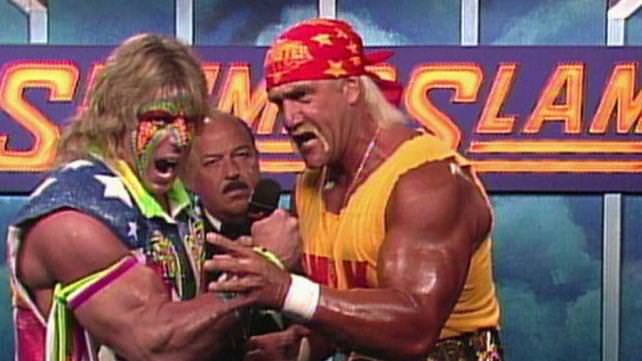
There’s also, amusingly, a catchphrase rule. At any point in a game a player can declare that a statement made by another player’s character becomes a catchphrase. You can’t choose this for your own guys. This has the potential to turn into a George Costanza “Big Shooter” situation, and I kinda like that. Anyway, if you work your catchphrase into your scene you get an additional die on your Mic Skills roll.
Commentary comes next, which is a bit weird. Mic Skills rolls for the commentators are required after every match, but there also may be commentary segments booked between matches. Now this part isn’t explained well in itself, only coming together with some information down the line, but commentary is generally targeted. If after a scene it’s clear that the commentary focused on a particular wrestler, match, tag team, or stable, you make a Mic Skills roll for each of the commentators, max 3. For each 6 rolled the target gains a point of Heat, etc. Whether or not a wrestler is being targeted should be noted on the booking sheet.
It’s also possible to bury people on commentary. If the person playing the commentator chooses to bury a wrestler, they can have each 6 rolled take away a point of Heat. On the other hand, failing a roll means the commentator loses 1 Heat for each 1 rolled. Finally, it costs a point of Clout to do this at all, unless they’re directed to do so by the promoter. There’s one good example I can think of this- back when he was more directly the heel commentator, Michael Cole would often single out Daniel Bryan for ridicule, going on and on about him being such a nerd. Whether this was the promotion actively trying to bury Bryan is still a little unclear- Cole WAS supposed to be a heel, after all- but it was stupid and annoying and Cole got a lot more tolerable when he dropped the gimmick. So I would advise against ever trying this.
How the actual commentary is handled is also addressed here- if the players have created the commentators, they should be the ones running them, unless they also have a wrestler in the match in which case they can hand them off. If nobody created any and the Booker throws them in as NPCs, players that aren’t in the match can share control. Or you can just not roleplay the commentary and roll Mic Skills at the end of the match, but where’s the fun in that?
The next section deals specifically with all the video magic that promotions with TV have access to. Even when a show is mostly broadcast live (like Raw and Smackdown are), a lot of the “backstage” segments and interviews will be pre-taped. If a wrestler doesn’t like how they rolled in an Interview or Skit, they can make a Clout roll; if they succeed, they can call for a reshoot, which involves everyone in the scene rerolling all Mic Skills or Wrestling rolls that were involved. The promoter may also call for a reshoot if they don’t like how things turned out.
Editing can also be used to enhance a backstage segment. The promotion rolls using its Production stat- if successful, for every 6 rolled you add a point of Heat on top of that already gained by the characters or match. Most of the time wrestling promotions do try to make these segments look as “real” as they can- no angle changes or music or whatever- though Lucha Underground is an interesting exception, deliberately making all its non-ring segments look like movie scenes. So if your promotion does things the typical way it may be a bit hard to explain just what’s being done here to make it work better, but maybe something in the lighting or the angle chosen, I dunno.
Entrance Packages can also add to a wrestler’s Heat- here you make a Production roll for each minute the entrance lasts (and having an entrance longer than a minute requires the “Entrance Package” Asset.) Of course this means having a longer entrance can backfire if the roll fails. New wrestlers are often teased on TV with promos leading up to their first in-ring appearance; here, a successful Production roll for the teaser can add to the Match Heat of their debut Match.
Video Recaps are special video packages hyping a specific match, summing up all the story business and prior developments and trying to make the upcoming confrontation look as important as possible. This is something the WWE in particular is great at- no matter how bad the angle they’ve been selling, the “truck monkeys” will make it look like the most important story in wrestling. Anyway, for every minute the package is, you can make a Production roll to add Heat to the match; a given match can only get the benefit of this package once per show.
Tribute packages to a wrestler can work to add to their Heat. In some cases this may not mean anything because the wrestler is, say, dead or retired, but I’ve actually recently watched an old Raw episode where Shawn Michaels was working a very dramatic fake injury angle, and there’s an incredibly sincere tribute to him during his absence that goes on for quite a long time, and the whole point was to get him more over on his return. Again for every minute the package is you can make a Production roll, Heat goes to the wrestler. Finally, advertisements for an upcoming show usually run 1-2 minutes, and every minute means a Production roll that adds to (or subtracts from) the Crowd Heat for that show.
Ah, Crowd Heat! We haven’t actually seen that yet, but it’s key to the next section, determining Match Heat. It’s something the Booker decides based on rules in the Booker’s Section, (the way this is organized makes doing a F&F really tough sometimes, let me tell you), but anyway it’s applied to each match in a show.
Match Heat starts with the average Heat of the participants- including Nostalgia Heat- and adds the Crowd Heat, as well as Heat from stipulations. There’s a list here with plenty of examples- an Ironman Match or Hardcore Match might add +2 Heat, a traditional Steel Cage Match or Ladder Match is +5, and a Cell Match (i.e. a cage with a roof on it), Last Man Standing Match (knock the other person out until they can’t answer a 10-count), or 3-Tiered Cage Match (as seen in Ready 2 Rumble) would be worth +15. A World Title Match gets +5, other Titles get +2. Finally add in any Heat bonuses wrestlers get from being in Tag Teams or Stables.
Match Heat during and after the Match can get moved around by three things. During a match, after every Move Set (and they still haven’t defined this), one of the players makes a Wrestling Roll. Success adds to the Match Heat, failure can subtract. After a match, if the target of the commentary was the match itself (this is the thing the game didn’t define earlier), the Mic Skills rolls of the commentators are applied to the Match Heat. Production can also add to- or more importantly, REALLY subtract from a match. A Production roll is made after the Match, and any 6s rolled add to the Match Heat. If the roll fails, though, every 1 subtracts five points from the Match Heat. This represents the camera missing a key spot and yeah, I can imagine this. I’ve seen a major TNA match where the camera actually missed the pinfall.
And because this next bit is going to be very important, I’ll give it its own post.
Next Time: We Learn How Matches Work
The Match, or Wrestlers Frequently Make Bad Decisions
Original SA post
The Match, or Wrestlers Frequently Make Bad Decisions
It’s finally time to wrassle. The basic structure of wrestling in Kayfabe is that the players take turns narrating the match, and the dice are used to determine how well it plays with the crowd. Each segment of narration, and the Wrestling roll afterwards, is a Move Set. The book talks a little about how during a match, wrestlers are constantly communicating with each other. Typically the way it works is the person who is going on offense tells the opponent what move they’re going to do, so the opponent can get into the right position. (If you’ve ever watched a Botchamania video, the “Everybody Talks Too Much” segments are basically the ring mics picking up the chat between wrestlers.) Essentially at any given time one or another wrestler is “in control”, and so their player takes on the duty of narration. (If both wrestlers were created by the same player, the Booker plays one.) This whole section starts with some basic advice on how to do it- describe what the audience sees, have the action go back and forth (i.e. don’t give yourself all the offense), and stick to the booking sheet. It’s fairly similar to how it works in KYR or World Wide Wrestling.
The question is, who’s in control? Matches traditionally start with the Heel doing initial narration, though the book says this may vary. (Indeed, in actual wrestling, the heel is usually the one controlling the match.) The players may decide, or they can make an opposed Wrestling or Work Rate roll if they can’t.
Anyway once someone starts narrating, there are five things that can switch the narration to someone else. One is if the focus of a match moves away from the narrating wrestler- say, if it’s a tag match and the narrator’s wrestler tags out, they’re not really the focus anymore.
A wrestler may try to Seize Control of the narrative, once per Move Set. They can do this if the narrator is making the wrestler do things they wouldn’t normally do, or exposing one or more wrestlers to unnecessary risk, or anything else that would make a wrestler in the moment try to take over. They can do this either by Carrying the Match- making an opposed Work Rate roll to convince the narrating wrestler that they know better, or by “Stretching”- taking control by force, which uses an opposed Wrestling roll. Stretching can be considered a Clout use if done maliciously.
The third thing that can happen is the roll at the end of the Move Set failing- this is interpreted as “Opponent misreads the narrator” and indicates some kind of miscommunication. The Move Set still took place, but the person who picks up the narration must explain what went wrong. If there are more than two wrestlers, the one with the highest Work Rate takes over, if there’s a tie then the Referee (either a PC or controlled by the Booker) takes over for a Move Set and then hands it off to someone of their choice.
Any time a new wrestler comes in, they take control of the narration. Finally, at any point the player can choose to give up control of the narrative to someone else.
So, the Move Set, defined at last. It’s a series of moves the narrator describes, adding up to 1 minute of match time and followed by a Wrestling roll. Whoever performed the bulk of the moves in the Move Set- which may not be the same as the narrator- makes the roll. The roll adds or takes away Heat from the match the same as it’s been described elsewhere. It may actually sometimes be the case that a minute passes without anyone actually making any wrestling moves- say they’re blown out or there’s some plot thing that changes the dynamic, etc. The Booker can either call for a Mic Skills roll here or just advance the time by 1 minute.
The Wrestling roll can be altered in a few ways. Some of it’s from Assets and Flaws which affect how many dice you roll, but also a wrestler can choose to Hold Back- to just sorta half-ass it for some reason. You can roll as few as zero, meaning yes, you can auto-fail a Move Set. I’m not sure why you would, but well, drama happens. Sometimes wrestlers get pissy.
Conversely, there’s “Sandbagging”. You know when a wrestler bodyslams or suplexes someone, the other guy is usually helping- they learn to shift their weight in such a way that they’re easier to pick up. Sandbagging is when you don’t do that, (edit:) or intentionally "no-sell" your opponent's moves (i.e. not making it look like they really hurt) and it’s usually for similar pissy reasons. Here it’s for basically any move that depends on the other guy to some extent, which for wrestling is pretty much all moves. Any time a Wrestling roll is made, a player involved can announce that they’re sandbagging and cancel out any number of 6’s rolled up to their Wrestling trait. The text mentions that “old school” wrestlers love to do this to kids they think don’t understand the need for cooperation. You can also intentionally Botch a Move Set- the mechanics work the same, but the rules specify this risks losing Clout unless it’s approved by the promoter.
But finally there’s an upside to all this. Using one of your wrestler’s Signature Moves in a Move Set means you can add 2 dice to your Wrestling roll; using your Finisher means you can add 5. These are cumulative, since a Move Set has many moves- if you use three sigs and your finisher, you’d get 11 extra dice. You can only gain the dice twice for every signature move, and once per finisher; however they can still be performed many times in the description. Also the way this is phrased, the benefit only accrues if the wrestler doing the move is narrating, which makes sense.
Wagering Match Heat is where your Work Rate comes in handy. It represents trying to pull off a big dramatic moment in a match- kicking out of a pin at just the last nanosecond, shrugging off your opponent’s blows, bumping the ref, etc. Once per Move Set the narrator can have their wrestler wager Match Heat up to their Work Rate stat. If the Wrestling roll succeeds, the Match’s Heat is increased by that amount (or to put it another way, you get back the wagered Heat x2), if it fails, you decrease it by that amount (i.e. the wagered Heat is lost.)
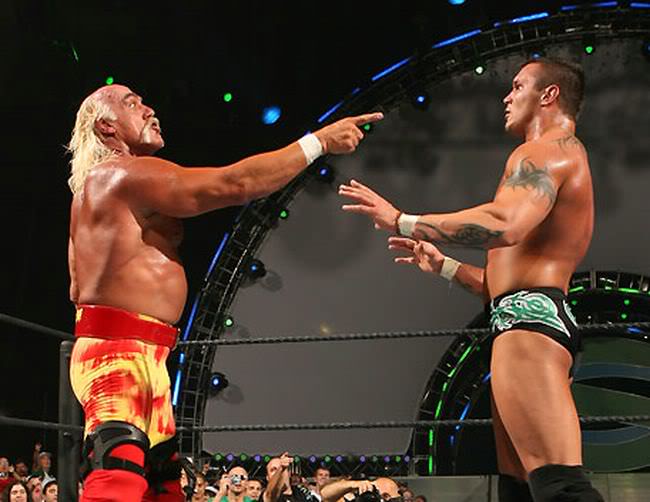
It is possible to try and “Shoot” during a match. Shoot is wrestling for “real”, and, yes, occasionally a wrestler will try to injure another for some reason. Most recently there’s been an issue with luchadora Sexy Star hurting her opponents for real, basically trying to make herself look more badass even though there’s now only one promotion that will book her. Anyway at any time the narrating player declares they’re trying to injure their opponent and by how much, and if the Wrestling Roll succeeds they do that much damage. It’s really easy then to hurt your opponent, which is- kind of accurate, sadly. Wrestlers really have to trust each other, they’re putting their bodies under someone else’s control in a way.
The balance to this is that unless the promotion has somehow okayed a shoot fight (which has happened- the WWF’s “Brawl For All” was a famous disaster, and the less said about Inoki-ism the better), doing this in a match means you lose Clout equal to the amount of Injury inflicted. It is of course also very illegal. So there’s that as a balancing force.
But even if the wrestlers aren’t being dicks to each other, there’s a chance of injury of course. Basically the Booker has to decide, after a Move Set is narrated, if injury has been risked, and there’s a table to help decide things. To summarize, working “stiff” (trying a little too hard to make your punches and kicks look real), working with chairs and tables and kendo sticks, and having anything performed by an untrained wrestler is Low Risk (2 points of injury); ladder spots and piledrivers and shit like barbed wire or thumbtacks are Moderate Risk (5 points); falls from around 10-20 feet and the use of explosives, fire, broken glass, etc. is High Risk (15 points); and there’s Insane, for stuff like falls from 30 feet or more, setting people on fire, using actual weapons, etc. that can result in 30 points of Injury or just plain death. If the Wrestling Roll for that Move Set fails, injury points are assigned. However, if the Wrestling Roll succeeds, an amount of Heat equal to the injury risked is added to the match.
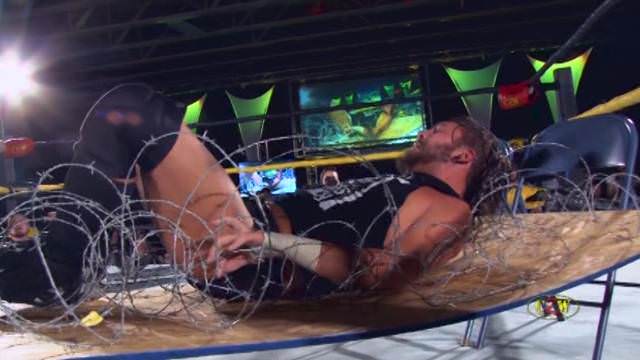
This was the least-gross picture of CZW I could find. For accuracy's sake, imagine there are a bunch of fluorescent light tubes everywhere and that the guy is bleeding profusely.
There are also times where the Booker may feel that injury is impossible to avoid and can just assign points automatically. Finally, there’s blading. This is the ancient practice of wrestlers concealing razor blades on their person, and when they’re about to take or have just taken a particularly sick bump, they cut themselves on a safe-ish place (usually the forehead) so they’ll bleed enough for the fans to see without really getting too hurt. Doing this in-game gives a wrestler 1 point of Injury and adds 5 Heat to the match. (Since publication, blading has fallen a little out of fashion- the WWE don’t want blood on their shows, and there was also a controversy with Abdullah the Butcher, who bladed so often he has permanent forehead scars, wrestling and bleeding without telling anyone he had Hepatitis C.)
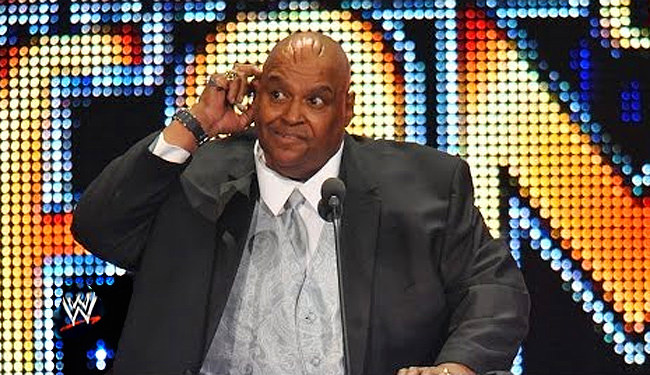
Abdullah the Butcher receiving the HOF ring he'd later have to sell to pay legal expenses.
Ending a match normally works pretty simply- you’ve done as many Move Sets as the time the match has in minutes, last Move Set should be the end of it. It is possible for the ref to end a match early as part of a management decision or due to injury. In the last minute of a match a wrestler may announce they’re extending a match to try and get more of their moves in- they simply explain how they’re extending (kicking out of a pin, or not pinning the other guy) and take control if they don’t have it already. If more than a minute gets added to a match the Booker may decide to have the referee call it, in which case whoever extended it loses a point of Clout. I am… actually not familiar with this particular kind of thing happening but I suppose it’s good that there’s a case for it.
Finally, a wrestler may try to change the finish. This requires an opposed Wrestling roll between them and their opponent. The chapter is nearing its end here so there’s no explanation of the consequences for doing this, but I think it’s fair to assume that they are not good. In real life “going into business for yourself” can be a career ender.
The chapter ends with a 7-step explanation of Match Advancement- basically a good summary of each “turn”- followed by an extended example of play, with Magnus battling the Vindicator for 7 move sets. We see Heat being wagered, injury being risked, control being taken over, even interference from a manager- it’s a pretty good breakdown of what to expect.
So that’s the wrestling part of Kayfabe. I like that it boils down to a simple process that can be made more complex by what you actually decide to do in the fiction. I do wish Work Rate mattered a little more relative to Wrestling, to better demonstrate how someone can actually get heat with a crowd while being technically sloppy, but I’m not sure how you would do that. (It could be argued that someone like Hulk Hogan would still have a solid Wrestling score- it's not like he's bad- and is just savvy enough to let his opponent do a lot of the work, while someone like the Ultimate Warrior had more problems living up to his image.) It’s generally a good system.
That wraps it up for The Show. Next Time, we begin our delve into The Booker’s Section!
The Booker's Guide, or, IT WAS ME AUSTIN!
Original SA post
By Matthew Gwinn
The Booker's Guide, or, IT WAS ME AUSTIN!
The Booker’s section begins by outlining some of the jobs of the Booker. The first is creating the Booking Sheet. Assuming a 2 hour show, the suggested breakdown is about half an hour for commercials, 50 minutes for matches, and the rest for skits, interviews, and promos- obviously there’s nothing forcing you to stick to that. The advice here is a little contradictory- in one paragraph they’re telling you to try to use as many of the players’ ideas as possible, in the next they’re telling you mess them up if it’ll add to the entertainment value of the game. There’s some advice to work in Assets, Flaws, and relationships the characters have into matches but they don’t get specific as to how to do that.
Finally, there’s one solid rule for the Booking Sheet. Match placement is done by the Match Heat (presumably at the time the sheet is put together.) The match with the lowest Heat goes first, then the next lowest, and so on- the match with the most Heat should be your Main Event. Ties are resolved by seeing which individual wrestler has the most Heat (though there’s no advice on what to do if this is also a tie.) This is not always how wrestling shows do it- these days Raw will typically have a sort of important match early to get your attention, then some less important stuff building back up to the main event. Still, it’s a useful abstraction.
The other major job of the Booker is to introduce Drama! This is all the stuff outside the show that’s gonna have an effect on the wrestler’s lives. Family issues, health issues, pressure from censors and the moral right back when wrestling was big enough for anyone to care, etc. Time for all those Flaws and Assets that didn’t have any obvious mechanical effects to come into play!
The advice here is kinda skimpy, really, with some potential problems- they talk about having, say, health issues or accidents outside the ring, but not really how you’d arbitrate that or if the players should have a fair chance. There is a nice list of plot twists, some of which are basic but I’ll pick out a few worth mentioning:
Competition- A rival promotion has bought a bunch of front row tickets and plans to mess things up. Will you remain professional or will you start a brawl? (Even the Monday Night Wars didn’t get this intense and smaller promotions nowadays are more “us against the WWE monopoly.” But it’s good drama.)
Sabotage- Someone has drugged a wrestler’s water bottle. Who’s done it, and how do they handle it?
Temptation- The boss’ girlfriend is putting moves on a wrestler. (Obviously anything like this has the potential for awkwardness, but eh, it’s a plot hook.)
Doing Favors- The owner may order a wrestler to deviate from the scripted outcome of a match and not tell his opponent. (For the uninitiated, this: https://en.wikipedia.org/wiki/Montreal_Screwjob)
Small Crowd- Due to bad weather or some other anomaly few people have showed up. Crowd Heat is almost dead and “there’s little hope of making it back to the hotel.” (I’m more interested in them trying to pump up a dead crowd than weather logistics, but still, versatile.)
The Booker’s job also involves establishing the cast of NPCs. This includes some of the options for PCs that haven’t been taken- referees, commentators, etc. - as well as the actual booker (the person the PCs see about getting matches changed), the ring announcer, etc. Obviously the Booker will also be playing NPCs who aren’t a part of the promotion but this is a good section for describing what you’ll need to flesh out the world of the game. I do have a gripe, though. The section mentions road agents, listing them as people who “travel around to smaller federations to scout new talent.” That’s not really what a road agent does. A road agent is someone who, in a promotion where people are on the road, takes the booking info from HQ and gets it to the wrestlers, and helps them actually put together matches. I’m not sure what the right name would be for the position the author describes here.
The “Being A Successful Booker” section follows, and, hmm. This is a game that gives a lot of power to the GM, which is not in itself a bad thing, and the advice section isn’t totally Play Dirty but there are a couple things which might give one pause.
The first couple of paragraphs are about how you shouldn’t be afraid to add and remove Flaws and Assets, and similarly award or remove Clout, based on character’s actions in play. Balance isn’t really an issue, which I guess in this specific kind of game is not untrue. This is pretty key to how things flow and it does go against a lot of the mentality of RPGs- instead of Assets and Flaws and stats being something the player has some solid control over, they’re very open to rewriting based on things that happen in the game.
The “Fire His Ass!” paragraph is one bit where I had to read closer. It says that you shouldn’t be afraid to fire a character who either runs out of Clout or does something to warrant firing. Here’s the phrasing:
quote:
Don’t be paranoid about pissing off one of your players; making a new character is
simple. Players should never take it personally if a character
gets fired (see below). Try to think of it like a character in
a fantasy game getting killed by a dragon. You can always
rehire him later, “resurrecting” his career so to speak.
I suppose one issue I’m having is that the game has punishments for characters behaving badly, but if they don’t act badly the game has quite a bit less drama- there needs to be some incentive for characters in the game to act as stupidly as people in the wrestling industry do in real life. This is a business where Sid Vicious and Arn Anderson once got into a real life fight in which at least one of them stabbed the other with a pair of scissors, Hulk Hogan sued Vince Russo for calling him “a big bald son of a bitch” on the air, and Brian Pillman used a fake firing story to actually get out of his contract. One of the paragraphs is advice to “Stir Things Up” but there’s not quite enough advice to this end. Digression over.
Next we get to “It’s Not Your Character Right Now!”, which clarifies a key idea in the Booking Committee phase of the game- that while the players are acting as writers they shouldn’t think in terms of the characters they control. The Booker needs to curtail/discourage bias on the part of the players in booking the show. I get the feeling this is easier said than done.
One bit of advice I like is “Give Everyone a Chance to Play”- which goes so far as to say that each player should have at least one wrestler in a match on a given show. The rest is general Good GM advice- be flexible, give out Bonus Dice, and don’t require that your players know the names of specific moves in describing a match.
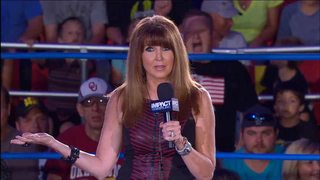
Next is a big job- Creating the Promoter. Since the Booker also plays the person in charge of the promotion, they have to work out who that person is. Promoters have Traits, Assets, and Flaws, just like everyone else, but there’s no point limit- you can assign whatever numbers you Clout score on the roster. like. They tend not to have much in the way of Wrestling or Work Rate, unless of course they’re wrestlers or ex-wrestlers themselves. Mic Skills are good if you want them to be on camera a lot, and the author recommends Clout be at least twice the highest score on the roster- though it will only ever be used if they’re dealing with other promoters.
But basically beyond that a Promoter can be whoever you want. The section lists a number of potential personalty traits and concepts, which can also be mixed and matched- though a few actually have mechanical elements. (If the promoter’s a Cheap Bastard everyone’s pay starts at 75% of what it would normally be and they have to negotiate to get it higher, if they’re a Financial Genius the promotion gets an additional point of Resources, a Romantic gets extra Match Heat.) This could be laid out better- the mechanics separated from the fluff- but it strikes me as a way of customizing a promotion.
Speaking of which,
Next Time we finally get around to every wrestling grognard’s dream, Creating A Promotion.
Creating A Promotion, Or, If Billy Corgan Can Do It So Can You
Original SA post
By Matthew Gwinn
Creating A Promotion, Or, If Billy Corgan Can Do It So Can You
I honestly feel this should come a lot earlier in the book. What kind of promotion you’ve got will have an effect on what kind of roster you have, what characters would fit best, the promoter you have in charge, etc. It’s the sort of thing where you need to have players and GM on the same page.
Wrestling Promotions have three traits: Production, Resources, and Facilities/Staff. Production gets used at various points during The Show (as mentioned earlier), Facilities/Staff is used to help your wrestlers improve their stats, and Resources represents your overall financial situation and, among other things, helps determine the size of your roster. The average indie promotion- and again it’s sort of implied that’s your default game- gets 12 points to divide among these three traits. “Players may decide” to have more or less starting out- a promotion on the verge of bankruptcy may have 4, a huge multi-million WWF-at-its-height deal might have 50 or 100. Or so the game says- I mean that gets you an average of around 16 or 33 dice in each Trait and who wants to roll that? I’d make it 24, maybe, for a big global company- you can pretty much max out your stats on that.
Once the stats have been set, you and the other players go about determining the Roster. A wrestling company may have a roster with combined Heat equal to 100 times its Resources Trait. It recommends that you have at least one of each character type (wrestlers, managers, valets, interviewers, and commentators) but the bulk should be wrestlers. So I guess the idea is you make a shit ton of characters (and it is very fast) and together the players decide what characters to officially sign. It suggests a couple of methods, one where players take turns selecting wrestlers, another where they pick a bunch and vote on them until the roster is filled. The game recommends getting as close to your Heat limit as possible- any excess is lost after finalizing, so have a few low Heat guys in there at the end. For this selection process, characters with 0 Heat are considered to have 1. (Phantom Heat isn’t talked about here but I assume it’s counted as part of the cost.)
It seems like this would take up the most time- totaling up Heat points can be a pain- but I do like the idea that you can leave some characters unsigned, possibly to pop up later. Still, considering that the average starting score for Resources will be 4, you got 400 Heat’s worth of wrestlers to buy, and a starting wrestler only has 5 Heat. Of course you’ll have some Experienced Wrestlers too, but my point is, rosters get big.
A promotion’s own total Heat is determined by adding the average Heat of your roster (this… could be hard to total up, I would honestly break out the spreadsheets) to the Production Trait. It’s very hard to determine what this will be on average, but there are benchmarks. Heat of 1-19 means you’re Unknown- only a few people know you exist and your shows can only be watched on the Internet. 20-49 is Local, you’re popular in the immediate area and you have a public access show. 50-99 is Syndicated, you’re known throughout the state and have a show on the “local” cable station (I’m not sure what they mean here). 100+ is National, you have a cable show.
It seems to me most promotions will start Unknown(because most of your wrestlers will be starting wrestlers with 15 or less Heat) and the description seems more suited to a REALLY small backyard federation (more on that anon), rather than just an indie fed, but the flavor text doesn’t really determine anything. In fact the entire scale seems a bit off, there’s no national vs. global, etc. I might bump everything up a level, or just make it more granular.
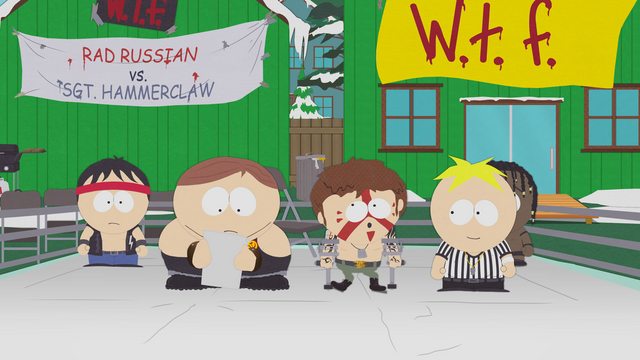
The book then devotes a page each to three special types of promotions. The first- Backyard Wrestling! This section even contains a little disclaimer about how, while the game depicts this because it’s a notable part of the wrestling world, they do not endorse such practices and you shouldn’t try this at home, etc. Backyard feds start with 4 points for Traits, wrestlers only get 5 points for theirs, and as the section notes, most backyard wrestlers are teenagers- the “Limited Availability” may mean they have a curfew. If a backyard fed isn’t being run to make money (and most aren’t), then they may have any number of wrestlers on their “staff”. The section also reminds you that wrestlers can’t advance their Traits beyond the Facilities/Staff Trait of the promotion, which will be on average 1. Really a backyard fed is going nowhere fast and it feels like this section is there because Gwinn felt it had to be. The thing about backyard wrestling is it’s sort of a weird painful form of LARPing to begin with, people don’t think this is their ticket to fame and fortune, so maybe making it nearly impossible to advance makes sense.
After that is Wrestling Schools. A few wrestling schools around the country are big enough to hold their own monthly or even weekly shows, which lets their students get used to working in front of an audience. A wrestling school gets 12 points for Traits (with the expectation that you’ll sink most of that into Facilities/Staff), and doesn’t use Resources to determine its Roster. Rather, each player is encouraged to select one experienced wrestler as a trainer, and up to 4 student wrestlers. As defined way back in chargen (but restated here) student wrestlers begin with only 6 points for Traits. To be a Trainer, a wrestler has to have at least one Trait that’s equal to or greater than the Promotion’s Facilities/Staff Trait. A school has to have a Trainer with Wrestling ≥ the Facilities/Staff Trait, and one with Work Rate ≥ the Facilities Staff Trait, or they can both be the same character.
Wrestling Schools also have a mechanic for “graduation”. Graduation requirements are chosen by the players, but the suggestion is for a character to have Wrestling and Work Rate Traits at 2 or higher. (Possibly adding Mic Skils.) Requirements can’t be higher than the Facilities/Staff Trait. Schools have a typical training period of two to six months, and after that time you determine who’s eligible for graduation. For each student that graduates, the promotion receives a number of Advancement Points equal to their combined Wrestling and Work Rate traits. It’s said that most promotions don’t get TV deals and have trouble with Heat because of the high turnover. Still, this seems like an interesting campaign model- there’s clear room for advancement and you can try out a bunch of characters.
Then there are Developmental Promotions, which the game defines as a step above Wrestling Schools. These are small indy promotions owned by larger promotions, which use them to further train wrestlers and basically have a talent pool to choose from for their main roster. The best example of this right now is NXT, which is WWE’s developmental program- they have shows they shoot at Full Sail University which air on the WWE Network, and actually have a bit of a cult following because they don’t get micromanaged as much as the main roster, but at any time anyone from there can be called up to the big leagues. (And sometimes wrestlers who’ve been having trouble on the main roster get sent down there to refine their skills.) The WWE have actually gone through a few before this, and set up contracts with indy promotions to use them as developmentals.
Developmental feds start with the Developmental Territory Asset, which gives them 1 extra point in Resources for each time it’s taken. Most characters will be Starting Wrestlers, with a few folks sent down from the parent promotion. These Visiting Wrestlers are considered to have 1 higher Clout than their actual Trait. A Wrestler whose Heat reaches 100 or gets their Wrestling or Mic Skills Trait to 5 or higher will typically be offered a contract by the parent promotion (as always, Booker’s discretion.) The promotion may require a tryout match, or they may act sooner if the Wrestler has Assets like “Born into the Business”, “Friends in High Places,” etc. Developmental promotions can get Heat and have TV deals and so on, there’s no problem there. If a Developmental promotion severs its contract with its parent (usually the result of the latter having financial difficulties), they lose the “Developmental Territory” Asset(s), and the Resource gain from it.
And this is looking like a long-ass post, so Next Time we delve into Assets, Flaws, and Advancement! Getting close to the end, folks!
Promotions, Flaws, and Running Multiple Promotions: More From Billionaire Ted's Wrasslin' War Room
Original SA post
by Matthew Gwinn
Promotions, Flaws, and Running Multiple Promotions: More From Billionaire Ted's Wrasslin' War Room
So Promotions have Assets and Flaws that you can get at character generation, but this time Gwinn actually went and assigned point values to everything. Every Asset and Flaw is rated in Advancement Points, and a starting promotion can have as many APs worth of Assets as it wants, provided it also has an equivalent number of APs from Flaws. A lot of these are pretty interesting, at least enough to be worth talking about on their own.
Annual Super Show (Costs 10 AP, 5 if it’s for charity) means your promotion hosts an annual “supercard” which features not only your wrestlers but many from other promotions- the show gets an extra die to the Capacity Roll (explained later, but determines whether you made a profit at the gate) and wrestlers from other promotions have fewer Contract Points to negotiate their guest appearance. This isn’t seen much in America, where WWE’s Wrestlemania needs no outside appearances, but I understand it is a thing elsewhere.
Backer (Costs 20 AP) means you have a wealthy patron (or “money mark”, as they are often called) behind the promoter- they have some influence, but this also gives you an extra die of Resources every time you take it. Ted Turner’s the best example here- for much of its early life, WCW was losing money, but Ted wanted wrestling on his cable networks and had some bad experiences with the WWF so that was that. (Later, after making a profit for a few years, they started REALLY tanking and Ted could no longer save them, but that’s another story.)
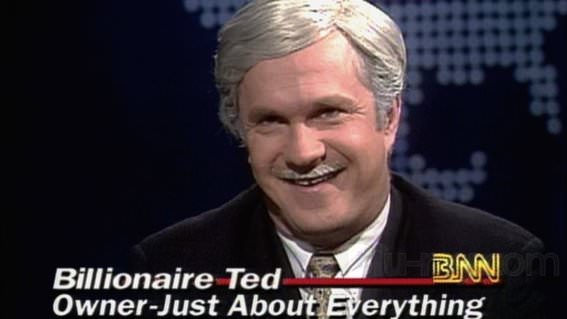
Vince McMahon's response to having competition was characteristically mature.
Farm System (Costs 20 AP) lets you do the inverse of the Developmental Promotion approach, and play a company which owns a Developmental fed- whenever you add a wrestler to your roster, they get one mechanical benefit from a list of 7 (including +1 to some traits, and Assets like “The Look” or “Mat Technician”.)
Some of the Assets reflect actual things the promotion owns- a Giant Video Screen (10 AP) adds to production, as does Pyrotechnic Equipment (10, but you can take this up to 5 times), while a Steel Cage (5), Steel Cell(10), or Specialty Cage (20) let you do certain kinds of gimmick matches. Stunt Coordinators (5) make dangerous moves safer. There’s also something called a Lucha Ring, which lets you add dice to a Move Set with high flying aerial moves, but I don’t actually know what this is referring to. Everything I’ve seen of Mexican lucha libre- or for that matter Lucha Underground- uses the same 4 sides, canvas-over-wood as everything else.
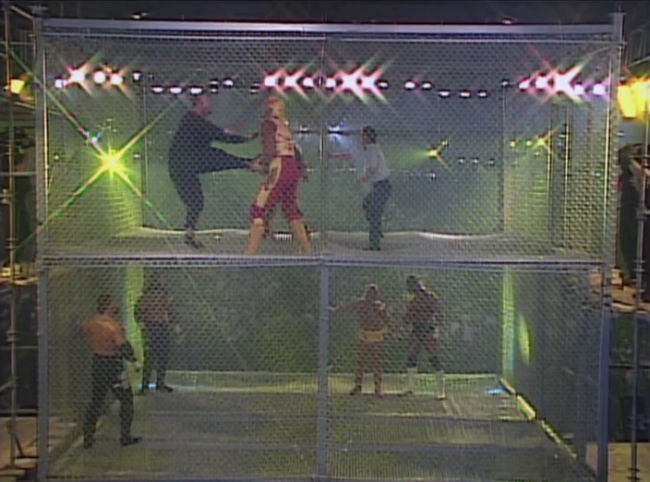
Pictured above: Why owning a Specialty Cage may not necessarily be an asset.
Then the Flaws! Bad Credit (worth 10) means you can’t take out loans and must book venues smaller than what your Heat would allow. A Dangerous Ring (10) increases the risk of injuries. You can have a Doctor Feel Good on your staff (worth 10 points) who makes it too easy for your wrestlers to get access to painkillers, and/or you can institute Mandatory Drug Testing (worth 10 or 20) which makes it more likely that wrestlers will get caught doing this (and at the higher level also costs you Resources.) There is no rule saying you can’t have both of these. Watch the fun!
One last one worth mentioning is Rival Owners which means there are two parties in charge who frequently disagree on how to do things. Whenever a wrestler makes an unopposed Clout roll they have to roll twice, and if one roll succeeds and the other doesn’t that means the owners disagree and the wrestler has to decide whether to press anything and risk the ire of the one they go against. It’s an interesting idea.
Basically having point values helps a lot- I can’t tell just how balanced it all is, but these in general feel better designed than the PC Assets and Flaws from a mechanical standpoint. Just about everything has a concrete mechanical effect. I legit get the feeling Gwinn did these later on in development and probably should have gone back and looked at the rules for PC Assets and Flaws and tried to bring them in line.
Advancement Points, like their name implies, are earned in play and used to improve the promotion. One way to earn them is by increasing the promotion’s Heat. After a PPV, you take the average Heat of all the wrestlers on the roster (including Nostalgia Heat) and compare it to their average Heat at the beginning of the series. If it’s lower, reduce the promotion’s Heat by the same amount; if it’s higher, increase it by the same. If the promotion’s Heat increases, it gains Advancement Points equal to the difference.
It’s also possible to gain AP by firing wrestlers! If a wrestler isn’t under contract or has 0 Clout they can be fired at any time. The promotion gains AP equal to that wrestler’s Heat. This kinda makes sense- you’re freeing up money to focus on other things, so it can be a useful desperation move, and it means there’s an upside when you do have to fire someone.
There are several ways Advancement Points can be spent. Medical Insurance lets you heal 1 point of injury form a character for every AP you spend. Advertising can be used to increase Crowd Heat during your next series, also on a 1 for 1 basis up to 10 points. Production and Facilities/Staff can each be increased by 1 per 20 AP spent- the former represents buying better technology, the latter hiring better trainers and giving them better facilities and so on. You can pay for a Special Guest to appear on a show of yours- the AP is used to “buy” their stats (1 AP gets 2 points of Work Rate, Wrestling, or Mic Skills, or 5 points of Heat.) This is paid each time. Finally, AP is used to hire new wrestlers, for a number of points equal to a wrestler’s Heat.
Then there’s a section on running multiple promotions. Basically this is an option for when you have a lot of players (more than five, so the game says)- you can split this large group up, run alternating sessions, even have different people acting as Booker for each campaign, etc. The default assumption is that they’ll be competing against each other, and this makes it possible for wrestlers to be scooped up by rival promotions.
Wrestlers in games with competing promotions get 5 extra Contract Points during negotiations, because they’re more in demand. A wrestler, however, may decline those points and gain either a point of Clout or the “Loyal” Reputation, Booker’s discretion. Characters who jump ship for another promotion reduce their Clout by 1. Also, if a wrestler goes to a promotion with more than double the Heat of the one they’re leaving, their own Heat is reduced by the difference between the two promotions. (Heat can’t go below zero, insert joke about Jeff Jarrett here.)
The section also notes a couple of things. One, that wrestlers can go back and forth between promotions if they’re not under contract (and indeed this happens all the time in the indies.) Two, that there are instances of cooperation in all the backbiting- interpromotional supercards have already been mentioned, but there’s also the symbiotic relationship between a developmental promotion and its parent.
And the rest I will leave for The Final Chapters! TV Deals! Ratings! Venues! Crowd Heat! All that and more (well, an appendix!) Be there!
TV Deals, Ratings, Finances, Venues, and Crowd Heat, or, The Thrilling Climax!
Original SA post
By Matthew Gwinn
TV Deals, Ratings, Finances, Venues, and Crowd Heat, or, The Thrilling Climax!
It’s the home stretch, folks!
Once a promotion’s Heat is 20 or more, they may be eligible for a TV deal- this is at the Booker’s discretion, though, and the contract will have to be negotiated as part of the Booking Committee.
There are two big perks to a TV Deal- Exposure, which leads to Heat, and a benefit to your Resources. Every segment of a televised show a wrestler is in, they gain an extra point of Heat on top of what they normally gain or lose, with a maximum determined by the station’s exposure- a Public Access Station only lets you gain 1 Heat this way, Local Cable (note that I’m still not sure what this is) caps out at 2, National Cable’s max is 4, and a Major Network gives you up to 8. (Though if a single wrestler is in that many segments there’s something wrong with your booking.) The drawback, however, is that Heat losses on TV are doubled.
When it comes to actually working out the details of a contract the mechanical details are sadly a little vague. A small promotion may have a contract that only lasts a single Series, networks might have different restrictions as to content, etc. (The game includes a potential network restriction being “No homosexual content”, but sadly that’s not too inaccurate at least for the time.) Basically the Booker has to decide a lot of specifics. The few mechanical bits involve how much of a Resources benefit a TV deal can give you, depending on the size of it: Public Access can give up to +2, Local Cable +4, National Cable +8, and being on a major network can land you as much as +16. The game also suggests that a TV deal will have a Ratings Requirement, usually equal to the Resources benefit you’re getting. Not meeting that requirement doesn’t instantly end the deal, but failing to do so four shows in a row can get you cancelled.
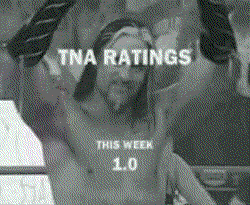
What’s that? Ratings? The game doesn’t give an objective scale, which is just as well given how much TV ratings numbers have fluctuated over the years. The way it works is this: you have a dice pool, called the Ratings pool, which starts at a number equal to your Production + 1/10 of your Promotion’s Heat (not sure if rounding up or down.) This is then modified by a number of factors. Holidays usually take away dice (people aren’t watching TV), pre-emption takes away one, a time slot can range from a -2 to +2 modifier, and broadcast range adds 1 die for Public Access, 2 for Local Cable, 4 for National Cable, and 8 for a Major Network. Any time a Match, Promo, or Skit gives someone Heat, you add a Ratings die- any time anyone loses Heat that way, you take one away. At the end of the show the dice are rolled, and each 6 means a point of Ratings. If you roll no 6s you effectively have a 0 Rating- almost nobody watched your show.
Now this has been the core dice mechanic for the game, so now at the end I finally looked up some probabilities. Your probability of rolling at least one 6 on one die is 16.667… %, about 30.56% on two, 42.13…% on 3, and is just a little over half with 4 dice.
Assuming an average starting promotion has 4 Production dice, plus maybe one or two from Promotion Heat, and the game says most promotion’s first TV deal gives them a bad time slot worth -2, and maybe that gets cancelled out by a 1 or 2 Broadcast Range bonus- well, that would still put us at about a Ratings Pool of 4 or 5. This would mean you’d most likely be getting a 1 Rating, which might not even meet the requirements of a Public Access station. But then we have to look at how often Heat is gained or lost on a show- and now I have to look up the probabilities of rolling two sixes or three, etc.
So it may be potentially difficult to keep a TV deal in these circumstances, but the Resources bonus is optional and if we’re being authentic here, what gave wrestling such purchase on TV was the fact that promoters actually sold their shows for cheap, at-cost or even less, because the real money was made at the gates, and later on PPV. (The WWE does make a solid profit from its current deal with NBC/Universal, but that’s the advantage of a near monopoly.) I guess what I’m saying is these mechanics are okay.
However there’s one major lacking thing here- it feels that there really should be a separate mechanic to determine the buy rate of a PPV. PPV success tends to depend both on how well the promotion is doing in general, and in specific how much they’ve “built” to the event in question- have they put together a card that people want to see, have they generated suspense over who will win, etc. I suppose you could figure Ratings for them like a normal show but I don’t think that is quite the same. WCW were going gangbusters in 1997, but January’s Souled Out show- a PPV that was in-story “run” by the evil heel faction the nWo- was a genuine flop because they made it clear that the non-nWo wrestlers had no chance and would generally be buried.
The next section deals with Payroll, and while I mentioned before the players don’t have a lot of reason to keep track of the money their wrestlers earn, the Booker sure as Hell does. A company’s Payroll is expressed in terms of real US Dollars (though I suppose they could be Canadian or even pounds or yen or whatever.) It starts the game at 0, but after each show you multiply the Promotion’s Resources trait by $500 and add that to its Payroll. This is then used to pay everyone off. For the sake of efficiency the Booker only has to apply this to the player characters, and by default only wrestlers who appear on a show get paid. Most of the time these people are paid after the show, after Payroll has been increased. Payment can be worked out ahead of time via a Contract, but if not, there’s a table provided- Wrestlers usually get their Heat at the the start of the show x $5, Managers and Valets get their Heat at start x $3, Ring Announcers, Commentators, and such are paid based on their Mic Skills, and Referees based on their Work Rate. (Ring Announcers get Mic Skills x $50 so presumably Michael Buffer had a Mic Skills rating of 2,000. Entirely possible.)
If a promotion doesn’t have enough money to make Payroll, they can simply not pay people and risk getting marked with the Bad Credit flaw, they can cut the roster, or they can negotiate with wrestlers to get them to take less- for every $100 a character defers, they get a bonus die on their next Clout roll, and for every $100 they waive altogether they get too. Wrestlers who aren’t getting paid and don’t have an agreement don’t have to roll Clout to refuse to work. A company can also take out a loan, gaining Resources up to its current Heat, and they repay that loan simply by reducing their Resources by the same amount- but, at the end of the series, interest takes it toll by reducing your Resources by 1 for every 10 you owe. If you go to 0 or negative Resources, well, you’re in default and theoretically that could be the end, but TNA still exists so who knows anymore.
This section concludes with a reminder that other expenses don’t need to be tracked, and can be understood based on the rise and fall of the Resources trait. Which is fair enough.
Venues are selected at the start of a Series, and are categorized by crowd capacity and the Heat a promotion should have if they want to fill the room. (Empty seats are bad not just for the usual “no money” reason, but also because a smaller crowd is less noisy and responsive and because it looks and sounds bad on TV.) At Heat 1-5 you’re “booking” backyards and parking lots with a capacity of about 50, and you go from there to banquet halls, school gyms, arenas and finally at 100+ Heat you can book domes or outdoor stadiums. The Booker should actually specify what these are, come up with names and locations etc.
Basically before each show, you roll a number of dice equal to 1/10 your promotion’s Heat (rounding up), plus one die for AP spent on advertising. This is the Capacity roll. If the Capacity roll generates one 6, you sold enough tickets to break even. More than one 6 and you make a profit, increasing Resources by 1 for every 6 rolled. If the roll fails, the company loses 1 Resources for every 1 rolled. If a promotion deliberately books a smaller venue than what their Heat allows, they get an additional Capacity die for each step down the list, but don’t gain any profit from a successful roll. On the other hand, if they want to take a risk, they can book a venue one level higher than what they normally have, roll one die less for Capacity and double the amount gained or lost from the roll.
So going back to probabilities. Starting promotions- and I’m assuming a starting Heat of 10-20 here- will want to be cautious, maybe deliberately booking smaller venues until they either A) have enough Heat to be rolling at least 4 dice, or B) have AP to spend on advertising. Again I wish there was a modifier for PPVs, which usually book bigger venues than the regular shows. Maybe have everything step up a size category? I dunno.
There’s also a bit here about saving money on venues by cutting costs, paying less attention to things like “sprinkler systems”, “emergency exits”, or “non-exposed wiring”. For each additional die you get to the Capacity roll in this way, there is a cumulative chance of disaster striking- you roll a d6 and if the number is equal to or less than the number of dice gained, something bad happens. Also, for every additional die you gain you reduce the Crowd Heat by 1 because seriously this place is a shithole.
The final mechanical section is about Crowd Heat. Way back in “The Show”, we were told that Crowd Heat is a number ranging from -10 to +10, determined by the Booker, and it gets applied to Match Heat. This section lists various factors that can determine Crowd Heat, in addition to those that have come up elsewhere in the rules (this really should have been compiled somewhere.) Every AP the company spends on Advertising increases Crowd Heat by 1 (so yeah Advertising pays off twice), and Crowd Heat is also modified by the Capacity roll- if it succeeds it goes up by 1 for every 6, if it fails it goes down for every 1.
Papering- giving away free tickets to fill up seats- increases Crowd Heat by 1 but takes away 1 die from your next Capacity roll. Canned Heat is pumping in chants and cheers over the speakers, and depending on a Production roll can increase or decrease Crowd Heat. Creative lighting/seating (another Production roll) can help negate the effects of a failed Capacity roll - if you ever go to a TV taping of a wrestling show, you’ll notice the audience getting clustered opposite the hard camera and near to where the camera’s likely to be during a match. (If things get really desperate the company can just build the stage farther out and use the set to block out empty seats behind them.) Where you’re running a show can also affect Crowd Heat but this is up to the Booker, but a wrestler performing in their home town adds 2 to Crowd Heat whenever they’re out there, and a promotion performing in its home town gets an additional +2 Crowd Heat to live scenes.
On the downsides, airing more than 10 minutes of prerecorded material in a two hour show reduces Crowd Heat by 1 for every minute you go over. (Obviously the WWE frequently tempts fate on this.) Finally, inclement weather can reduce Crowd Heat up to 5 points.
And at last, there is an Appendix, listing off various popular match stipulations, from basics like Tag Team matches and No DQs to Flaming Matches (the goal is to light your opponent on fire), 3 Tiered Cage Matches (a bizarre specialty of WCW) and ___ on a Pole matches (a specialty of Vince Russo.) TNA was just getting started when this book was written so sadly there’s nothing on Lockbox Challenges, King of the Mountain matches, or Reverse Battle Royals.
And that’s it!
Aftermath: Talking Kayfabe
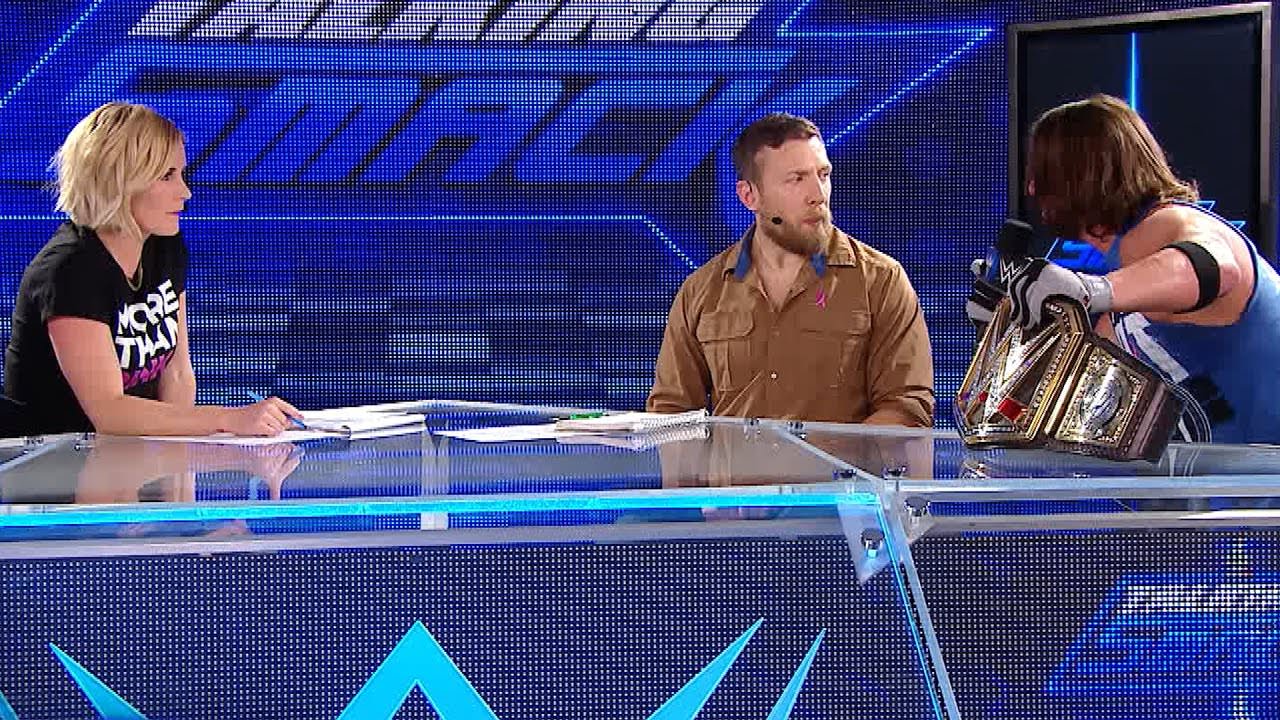
What I get from this game is that it could be fun but also would be very involved to play. There are just a lot of things to brainstorm- so much happens on one single wrestling show, which is one reason the individual stories have to be so simple. To play this game everyone needs to make a bunch of characters, make some decisions about what kind of wrestling company they wanna be involved in, there are a few tricky calculations (averaging everyone’s Heat to get the promotion Heat seems like it’d be best done on a spreadsheet), but if you can find a group of wrestling fans who really want to go that extra mile, there’s a lot of potential here. The basic system is solid, and that it leaves a lot up to GM Fiat isn’t a dealbreaker considering how much of a narrative game this is.
The chief pitfalls of the game are some shaky organization and, as I’ve said before at least twice, not enough mechanical incentive for the characters to do the stupid things people in wrestling companies do all the goddamn time. I would love a second pass at this material, refining a lot of its ideas and incorporating the many techniques of storygaming that have been developed in the 15 years since this was released. The dirty real business of wrestling can be, in its way, as entertaining as the battles on screen, and I’m glad there’s at least one game out there that lets you get involved with it.
So, give this game a look if wrestling is your thing, and as always, remember:
